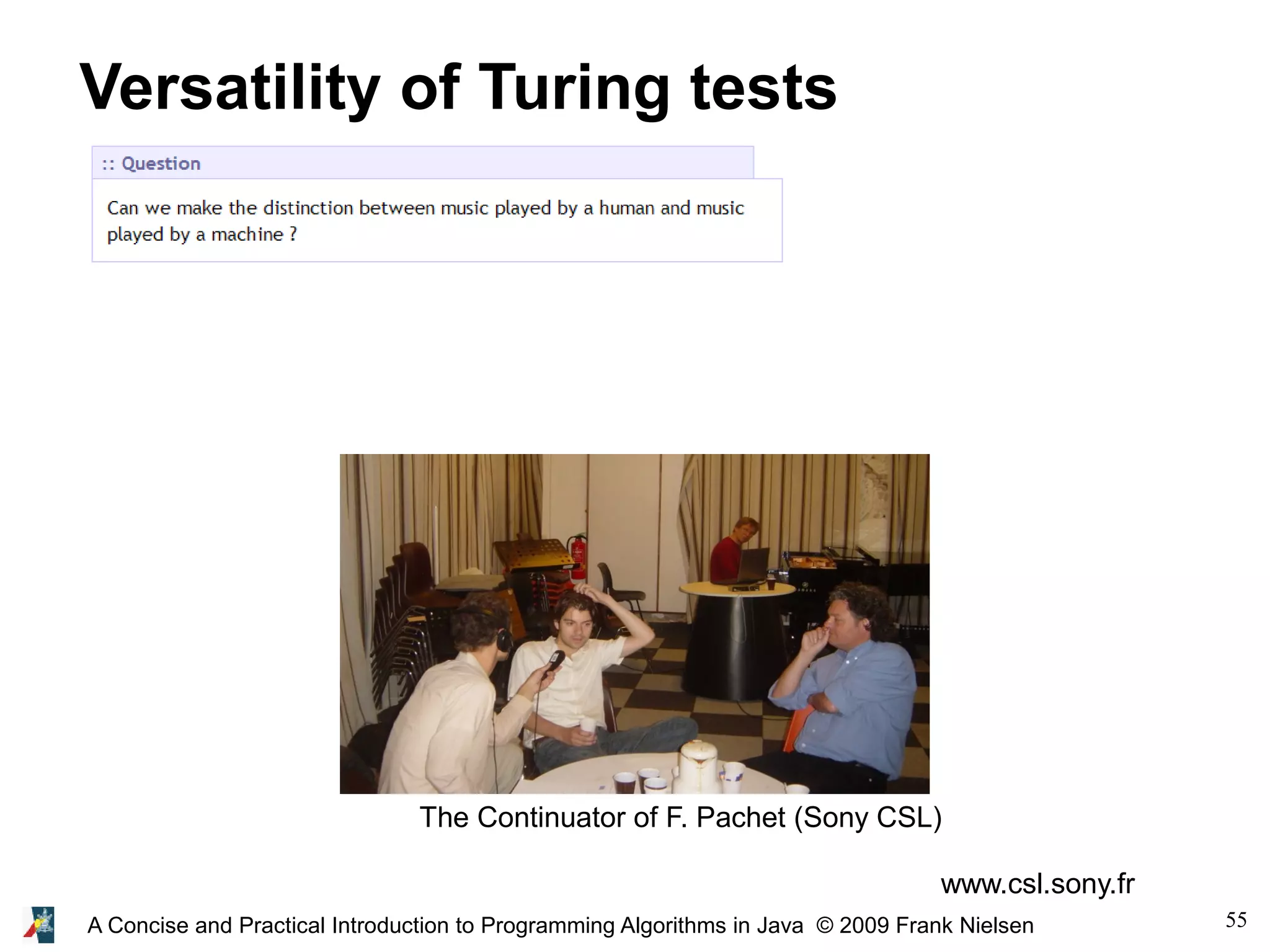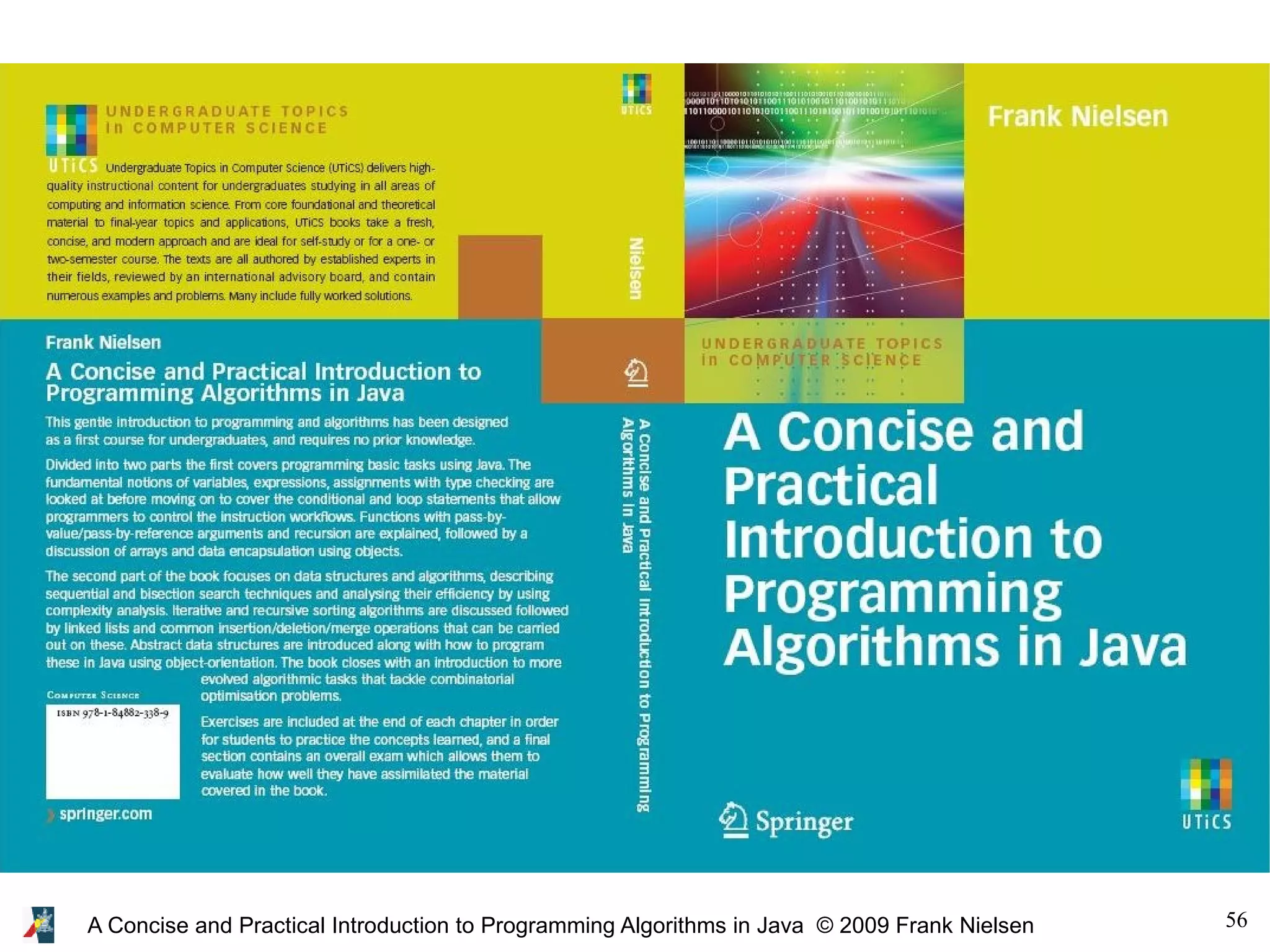This document is a comprehensive introduction to programming algorithms in Java, covering fundamental concepts such as expressions, variables, data types, and algorithms. It highlights the transition from analog to digital computing, the importance of computer science in various domains, and provides practical examples of coding in Java. The material emphasizes the role of algorithms in problem-solving and the significance of programming languages for effective communication with machines.
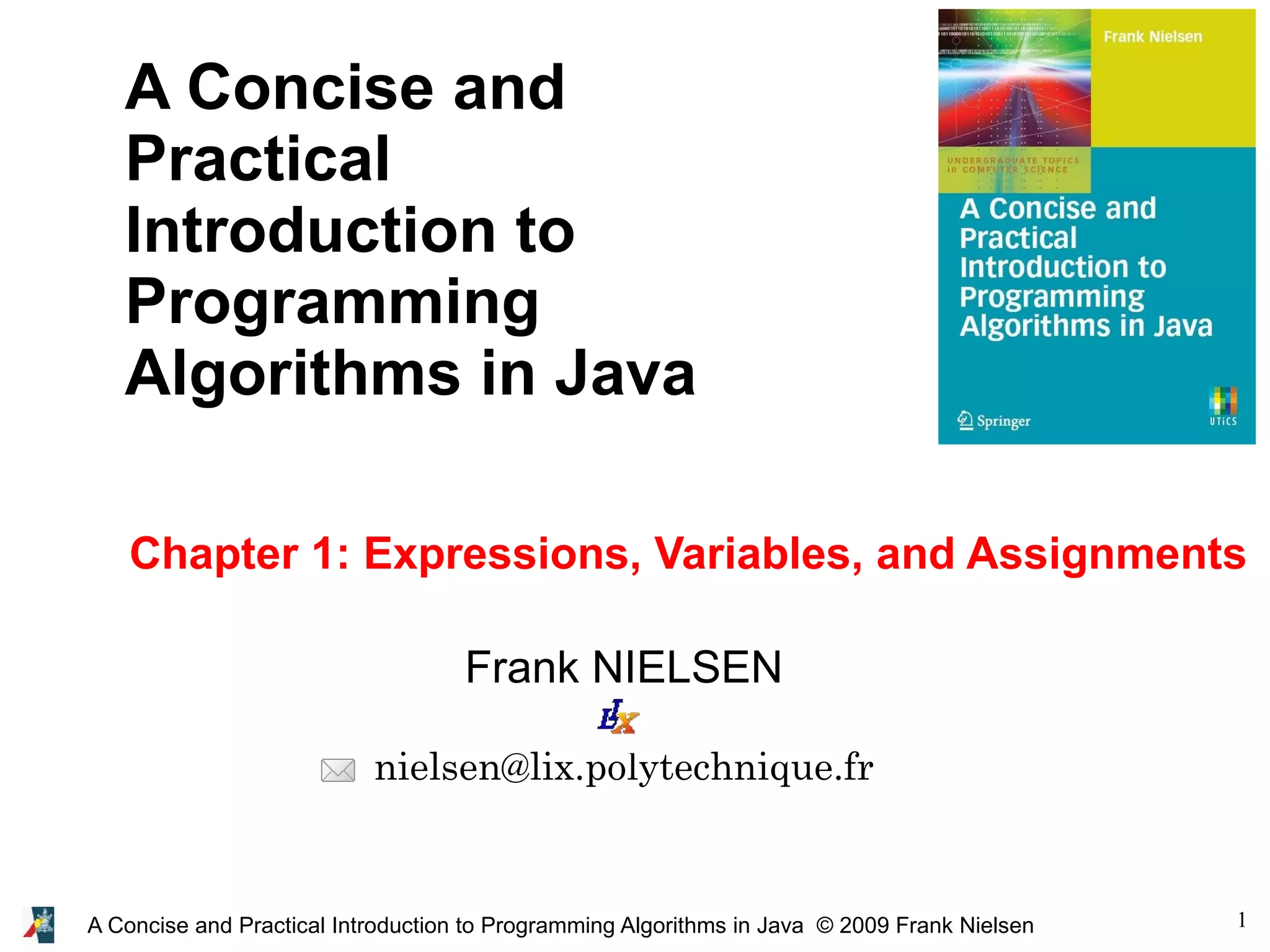
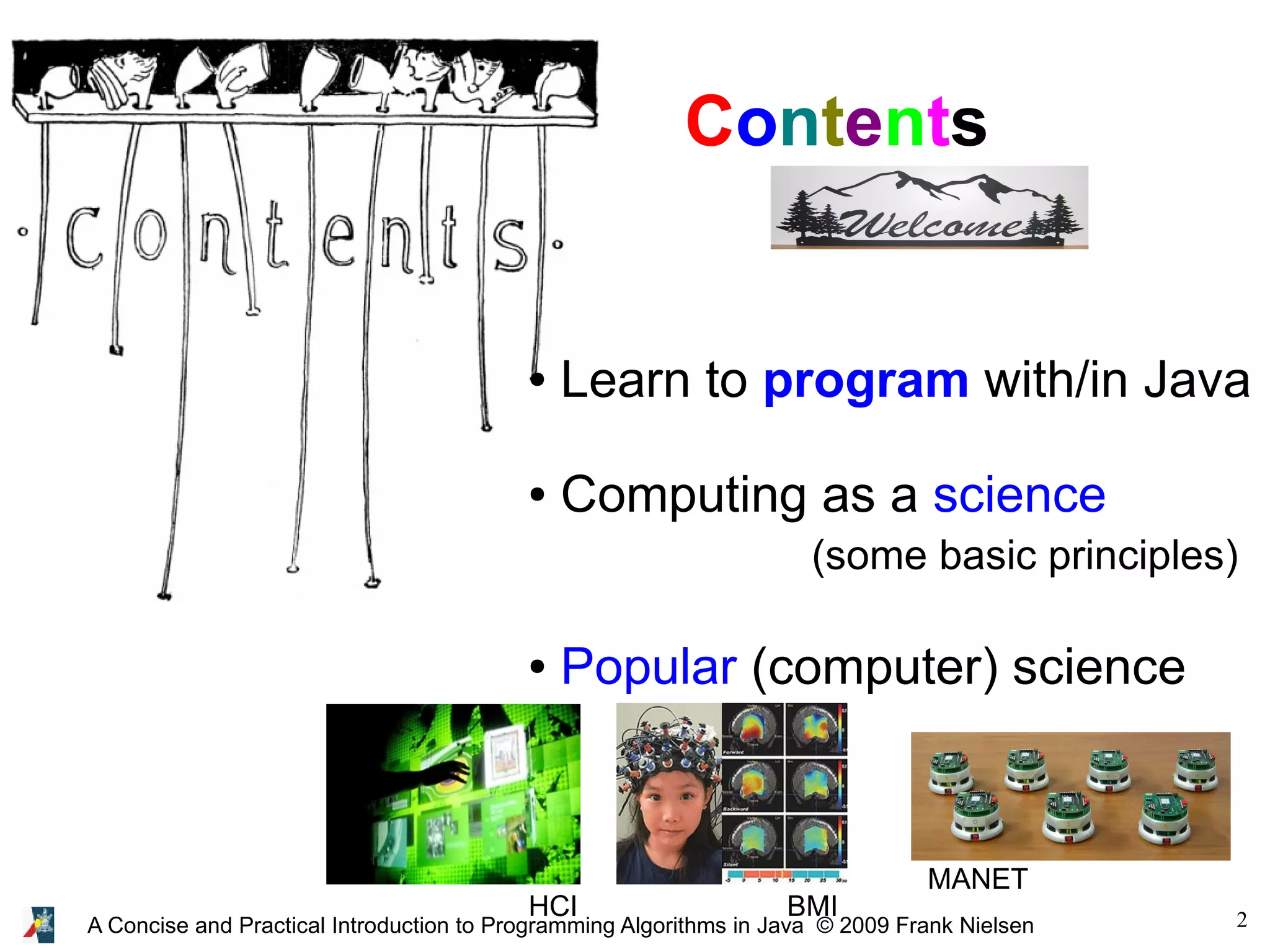
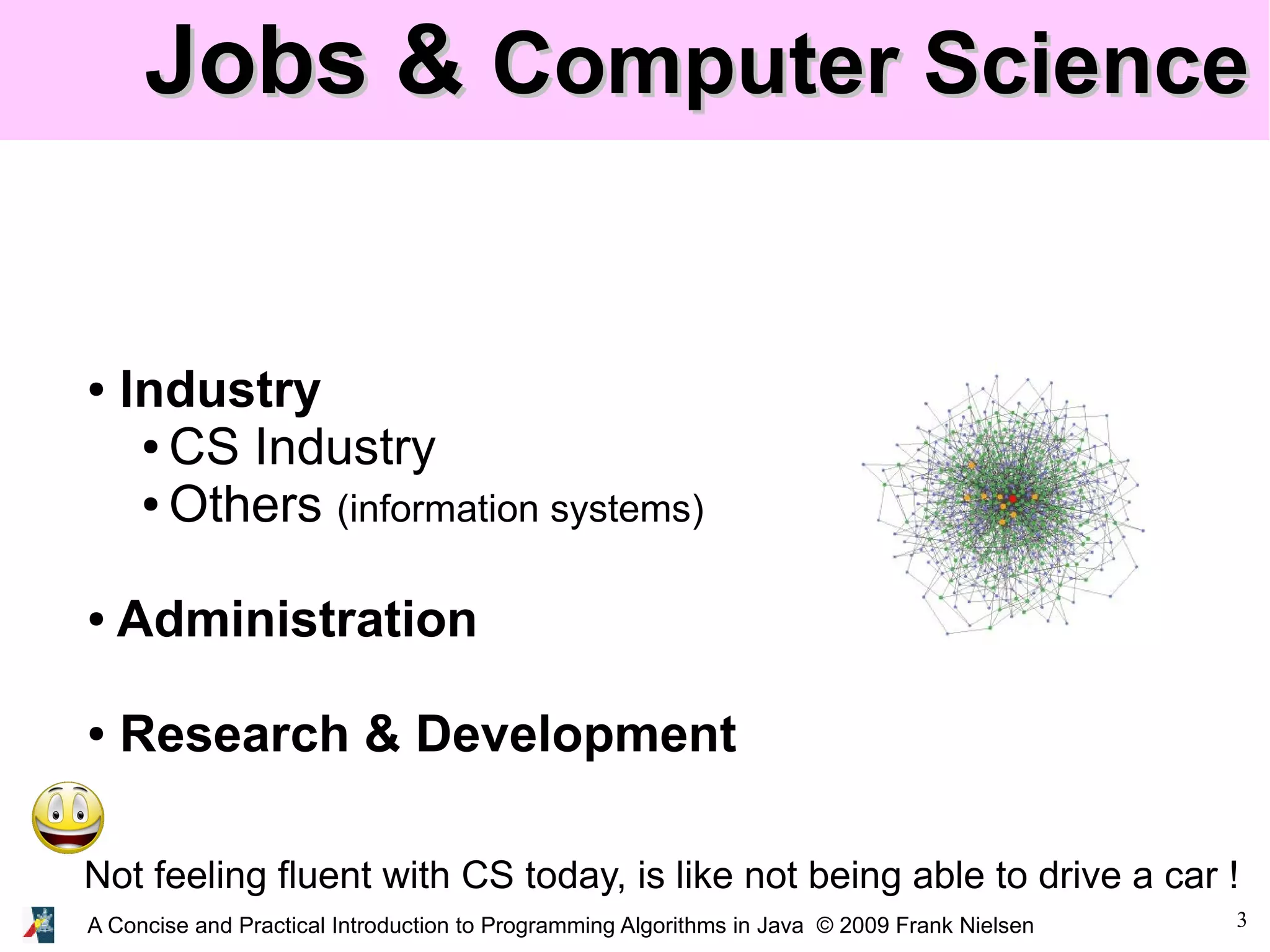
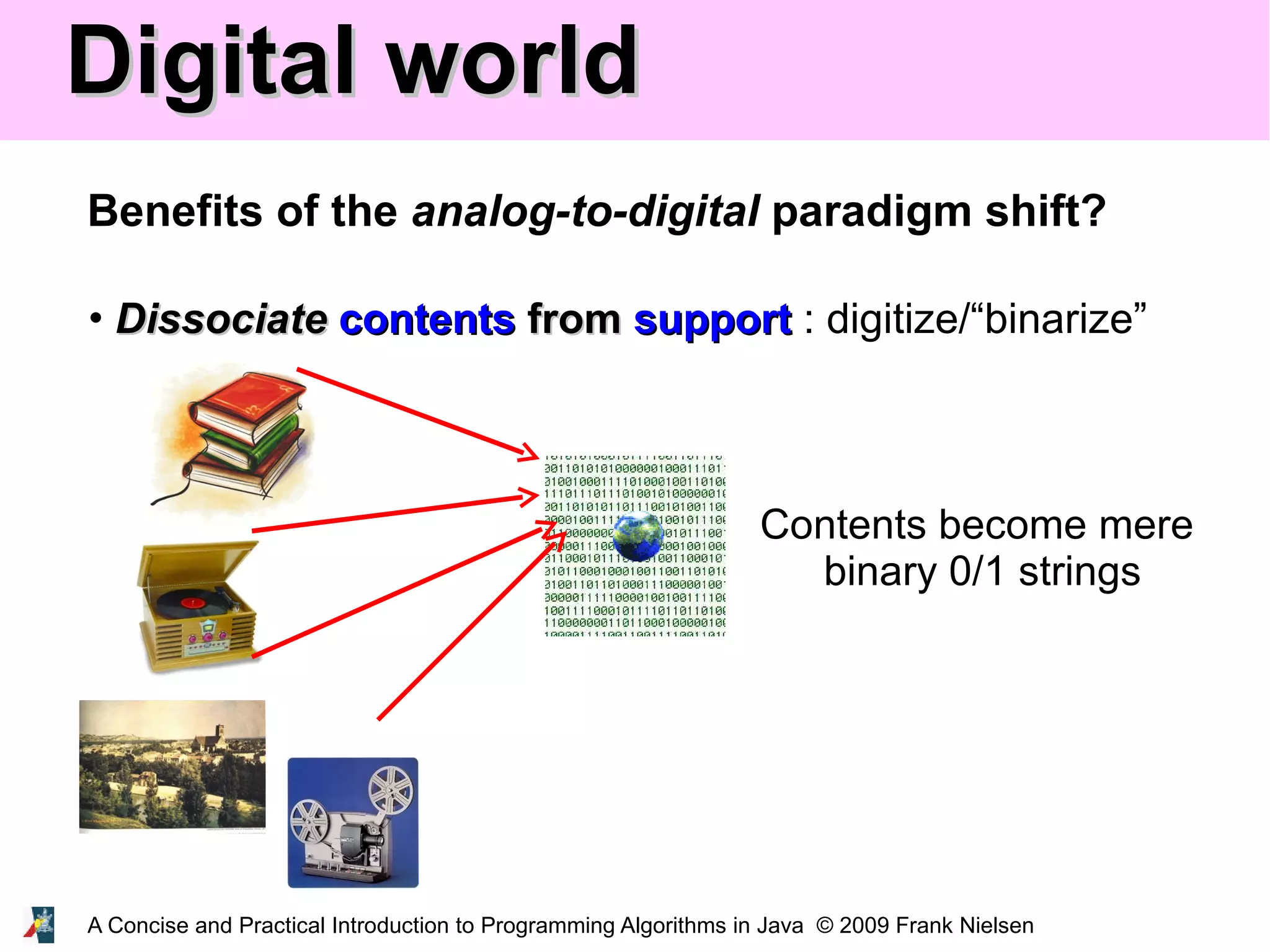
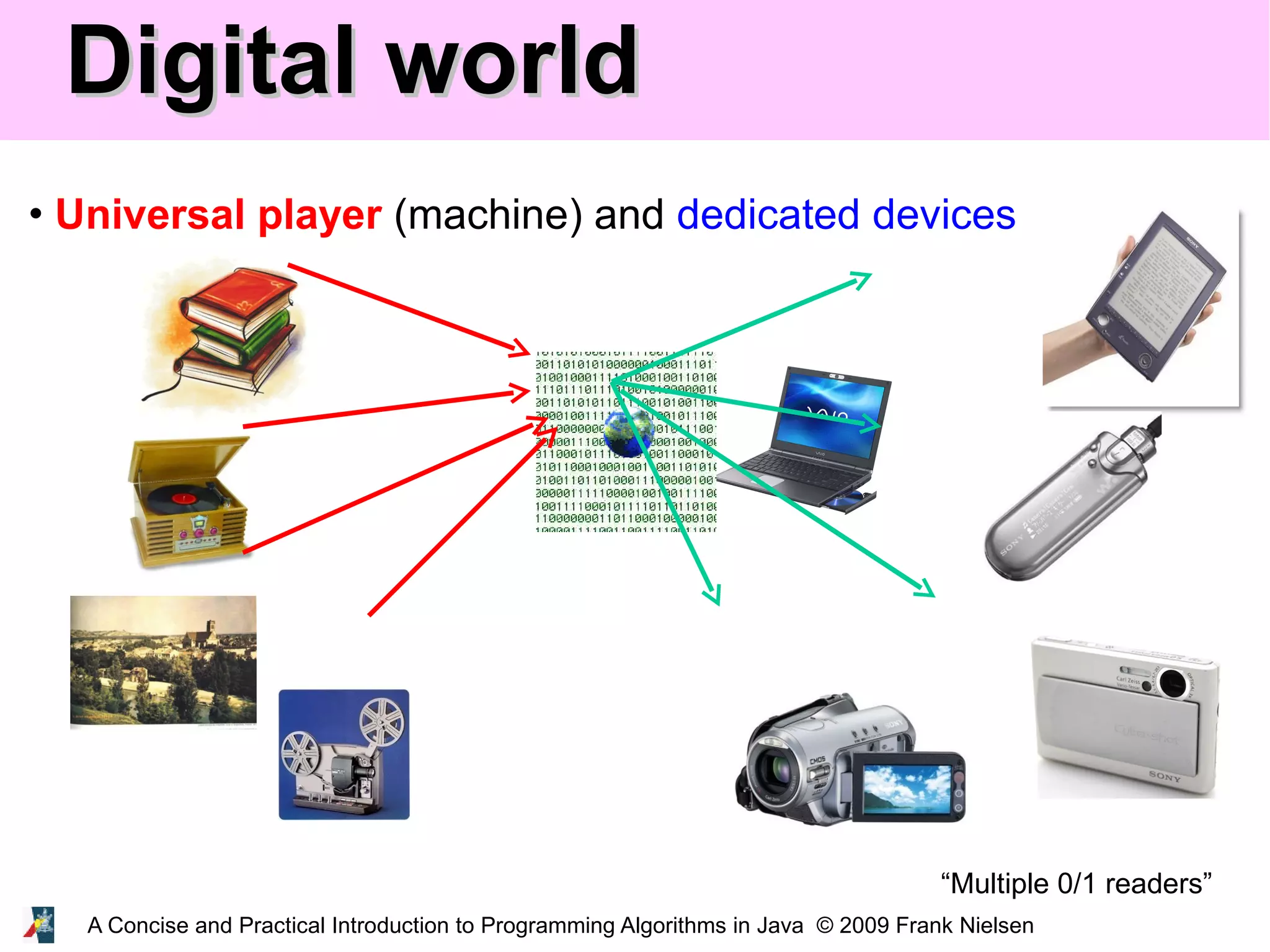
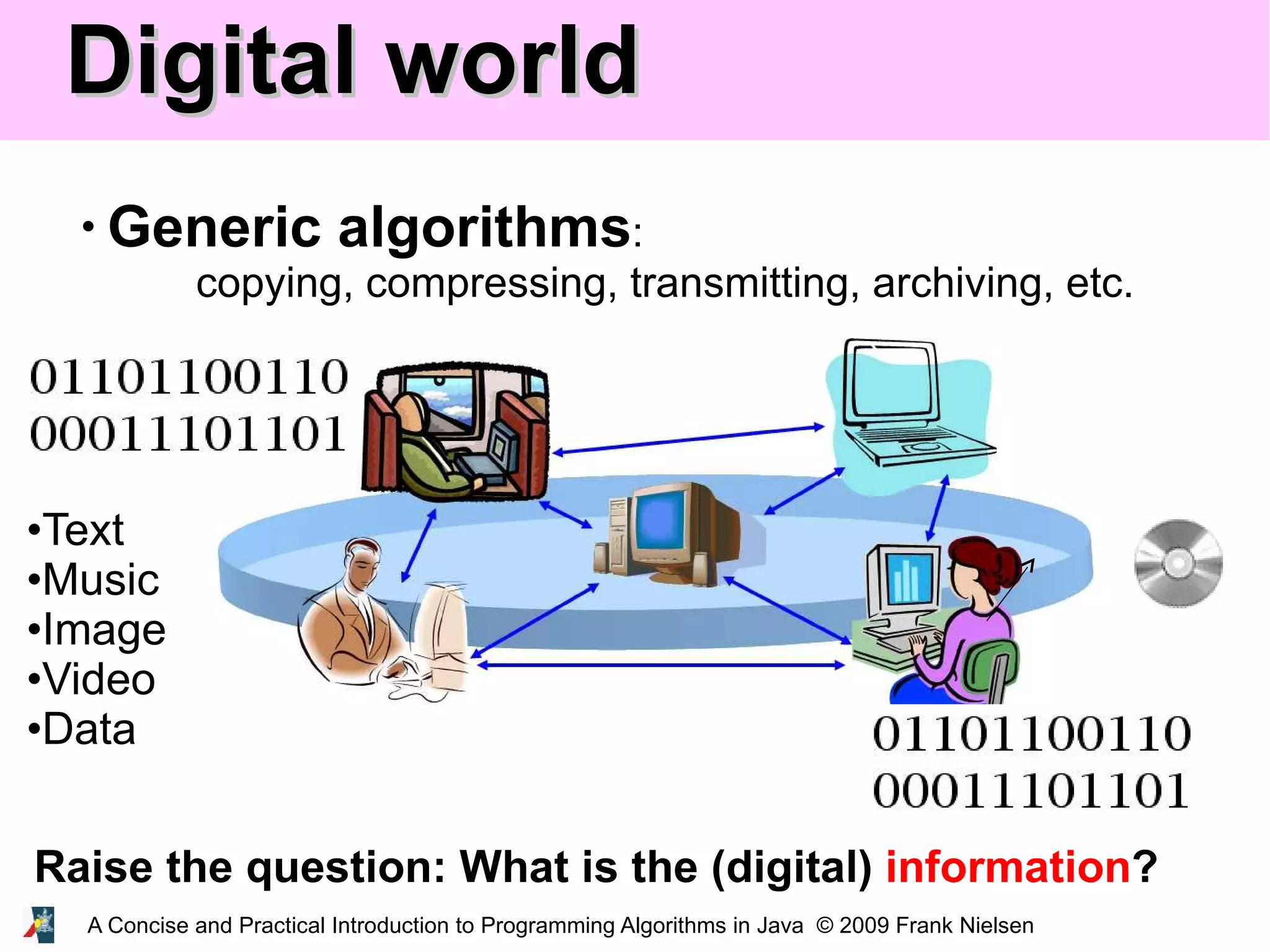
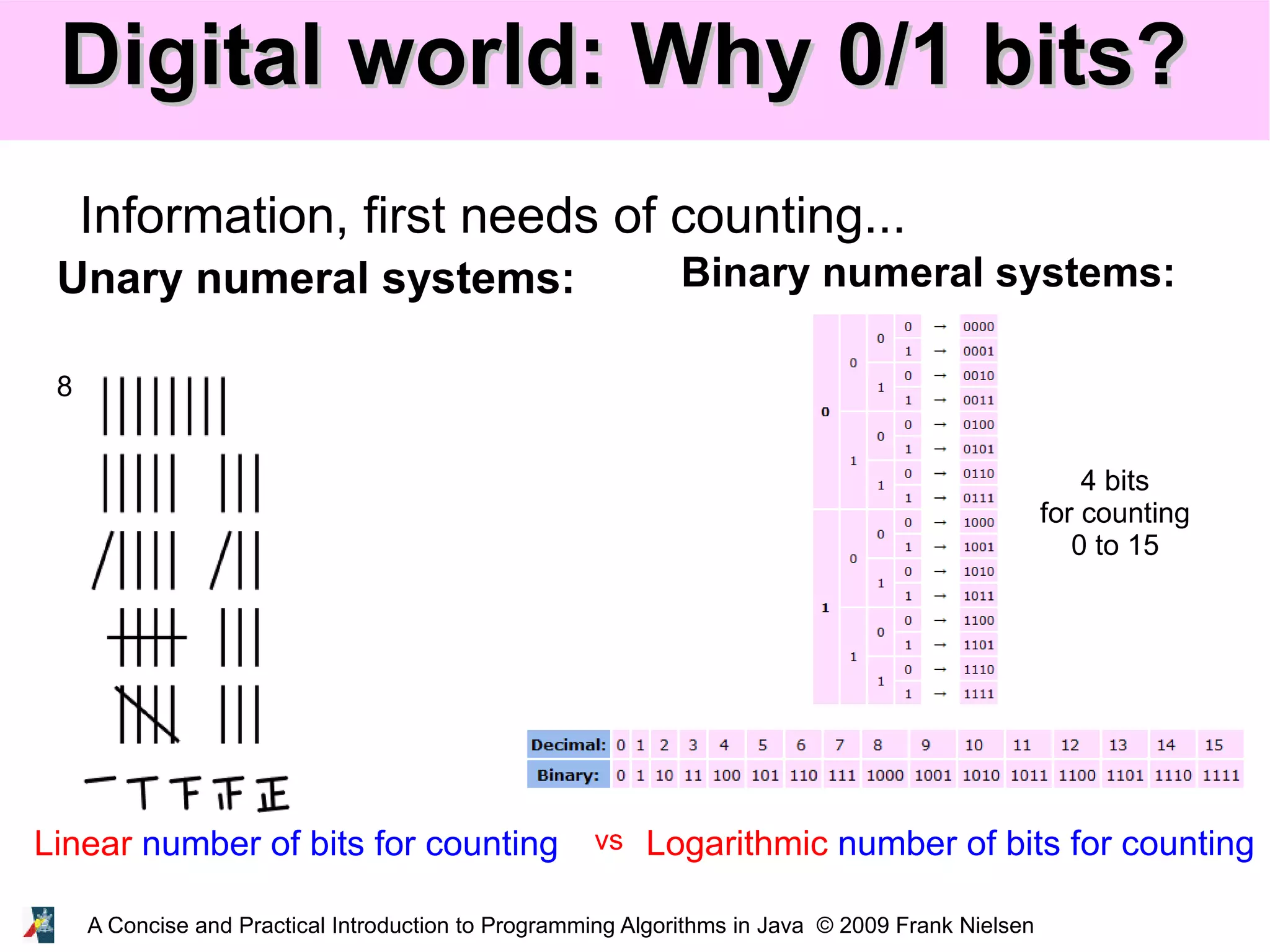
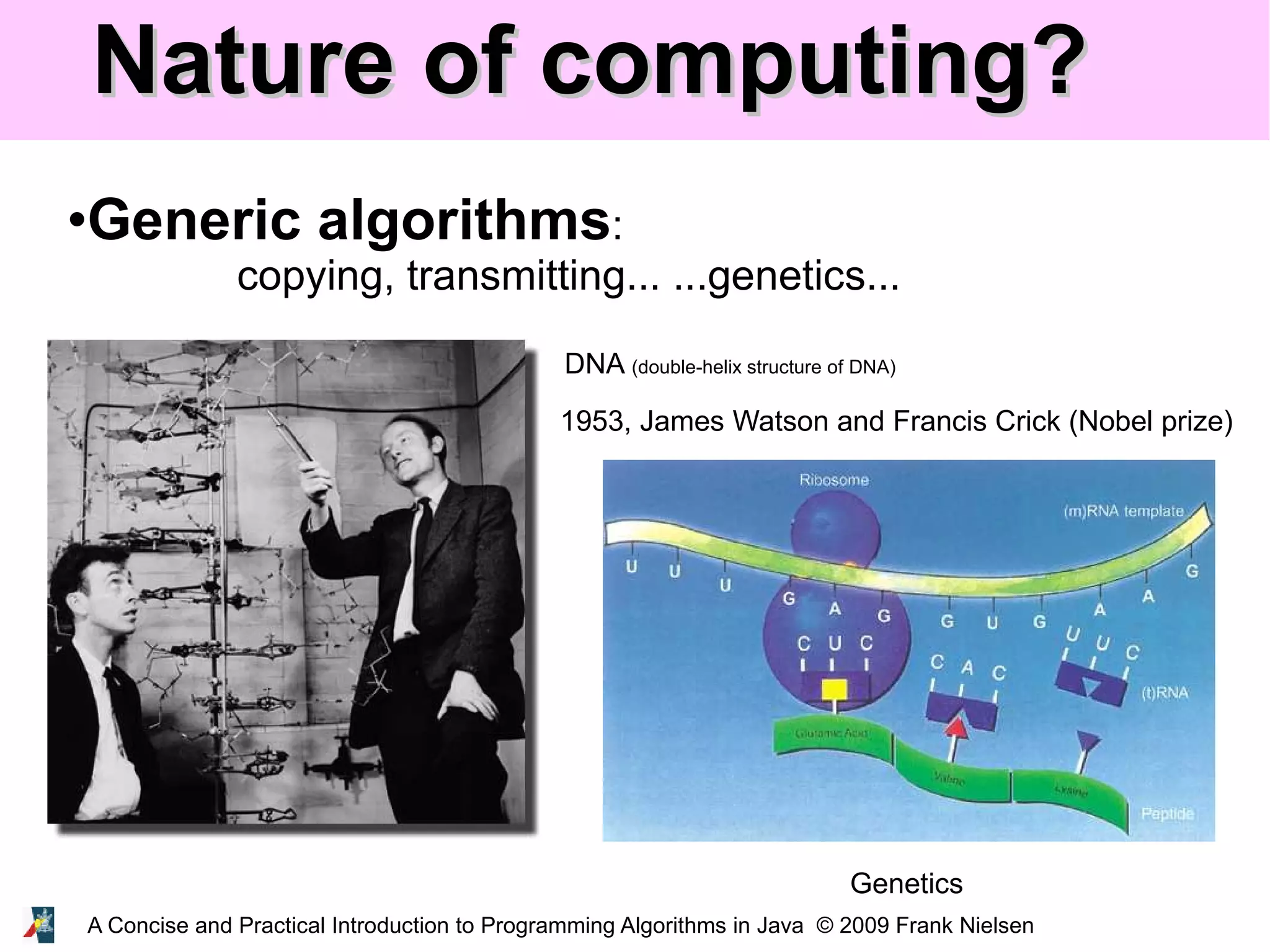
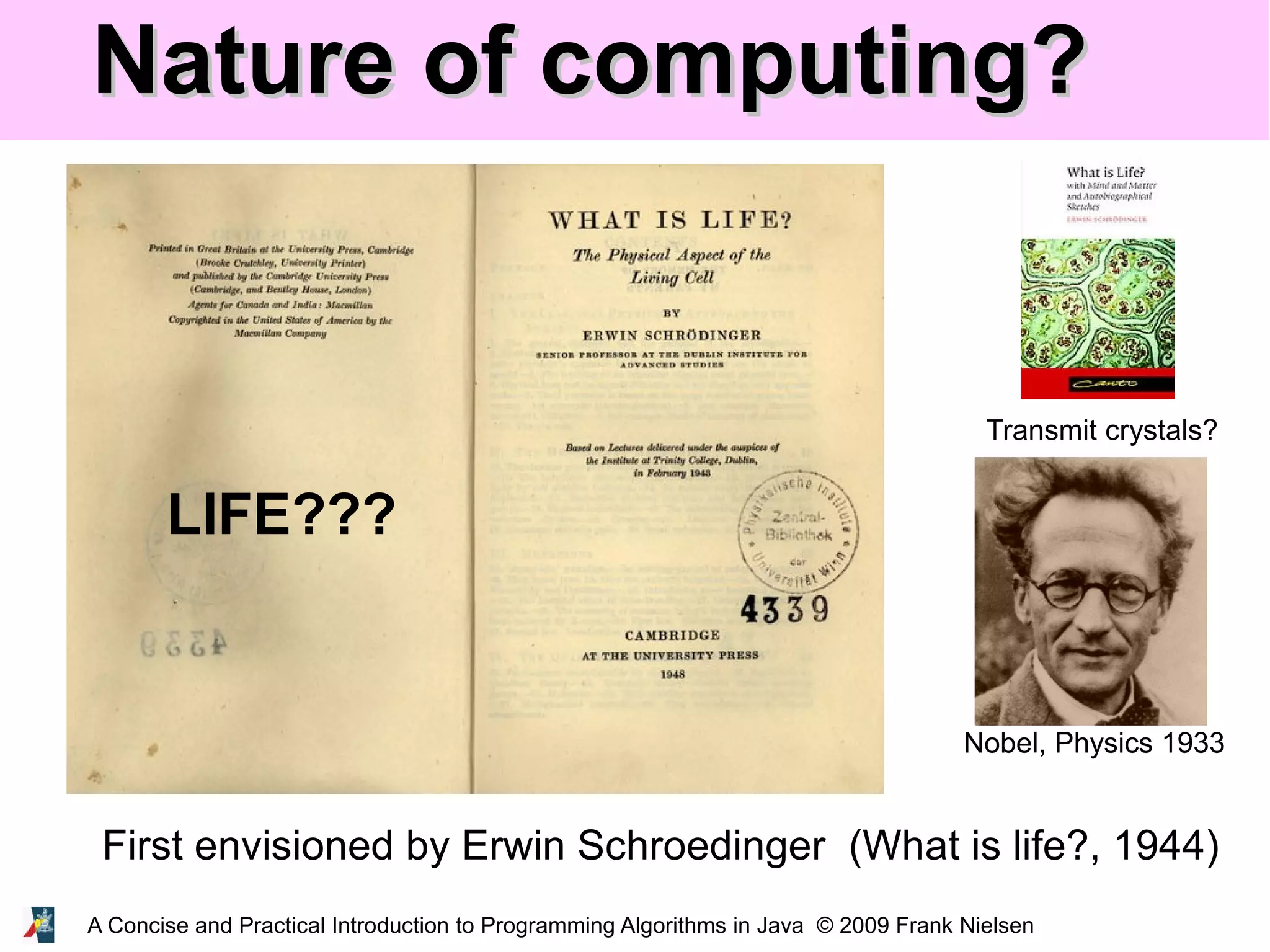
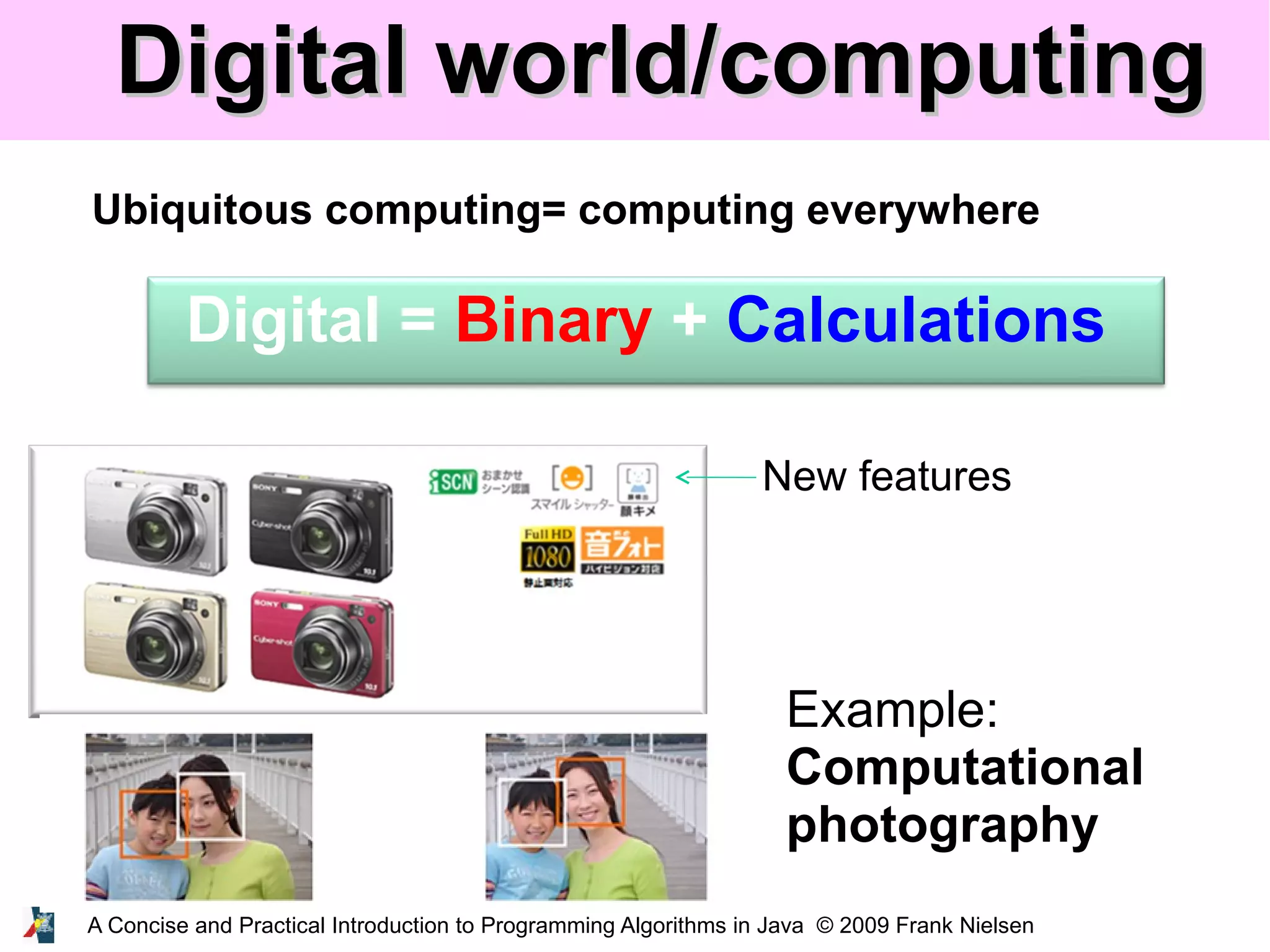
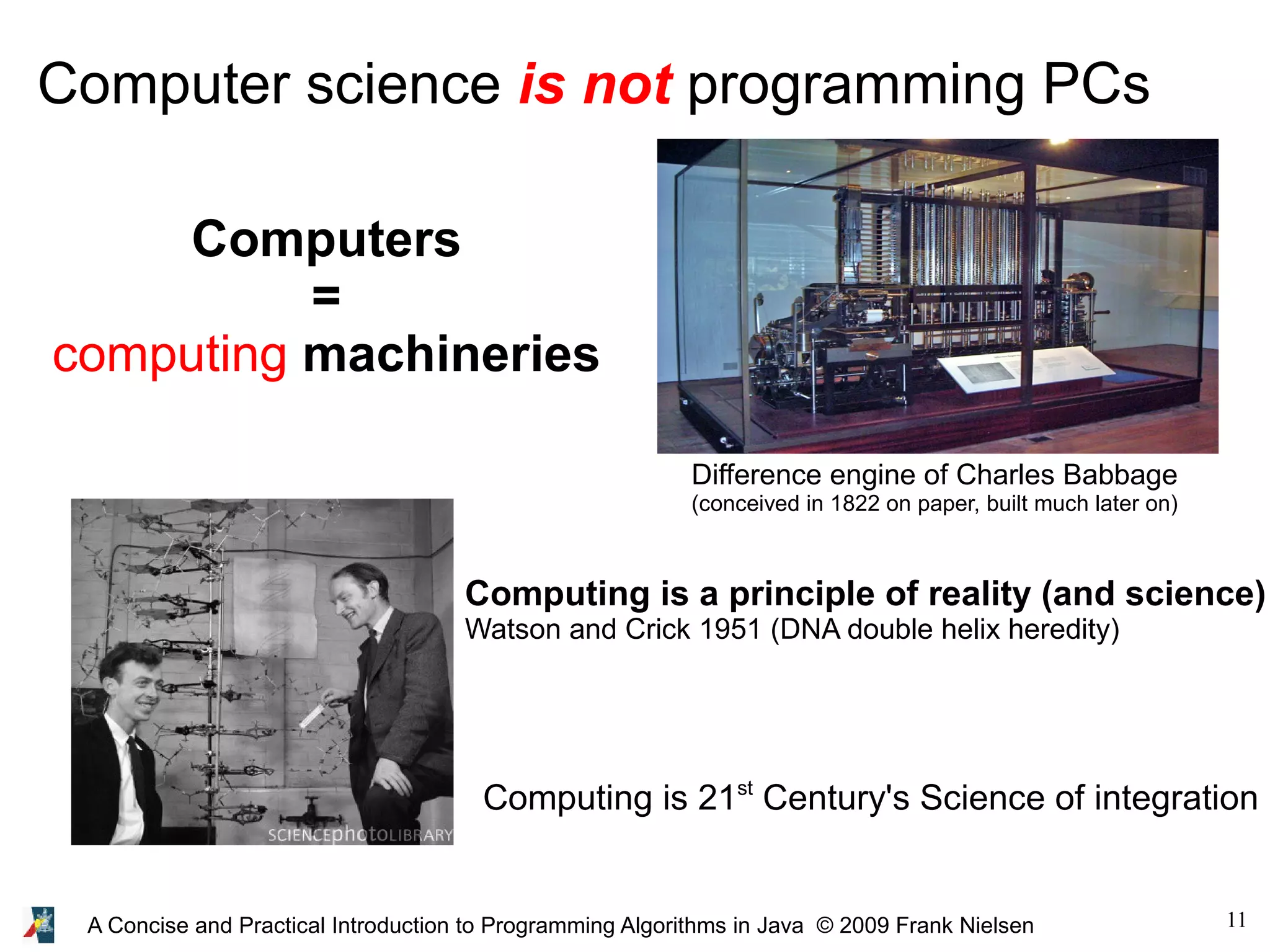
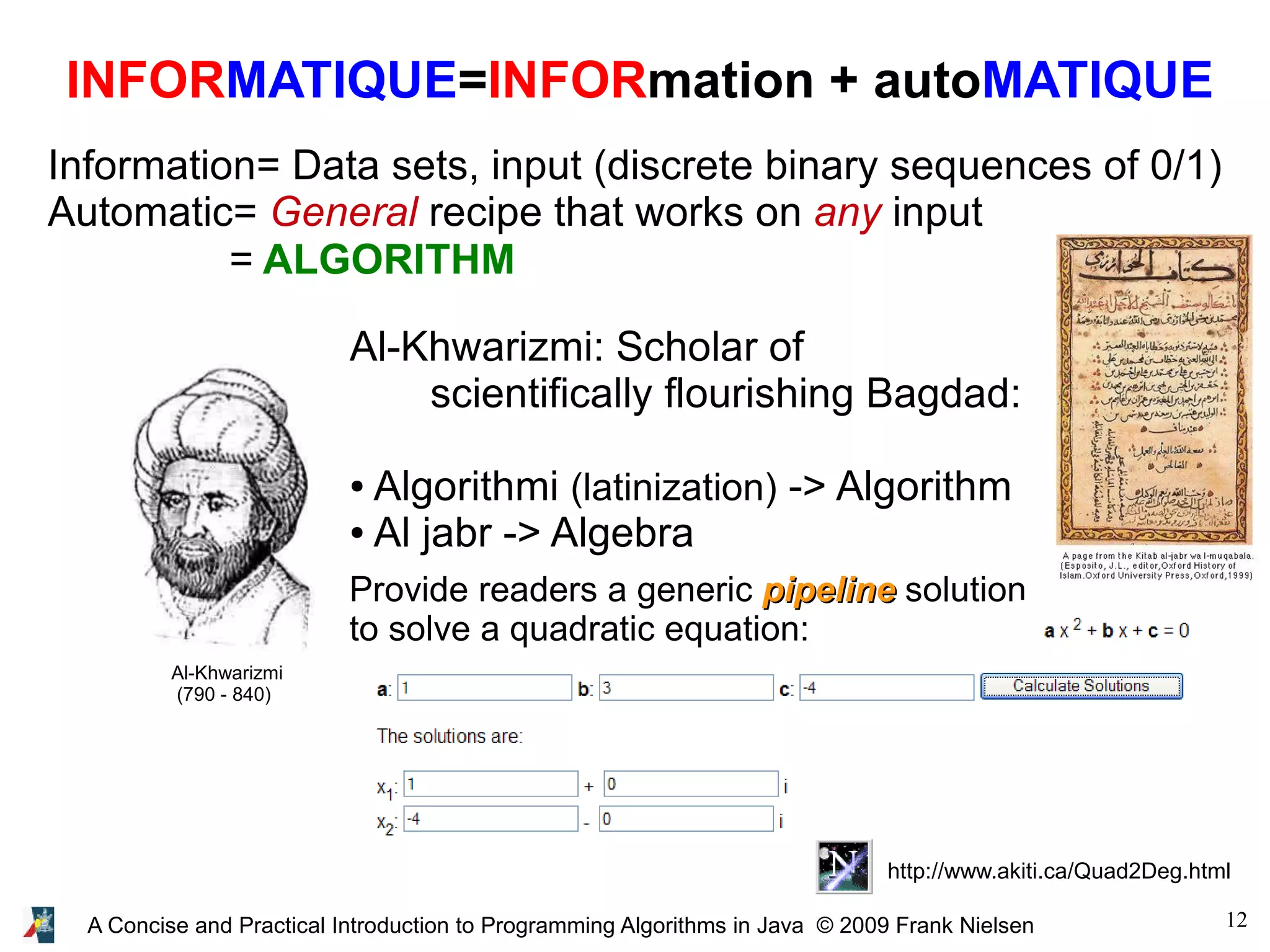
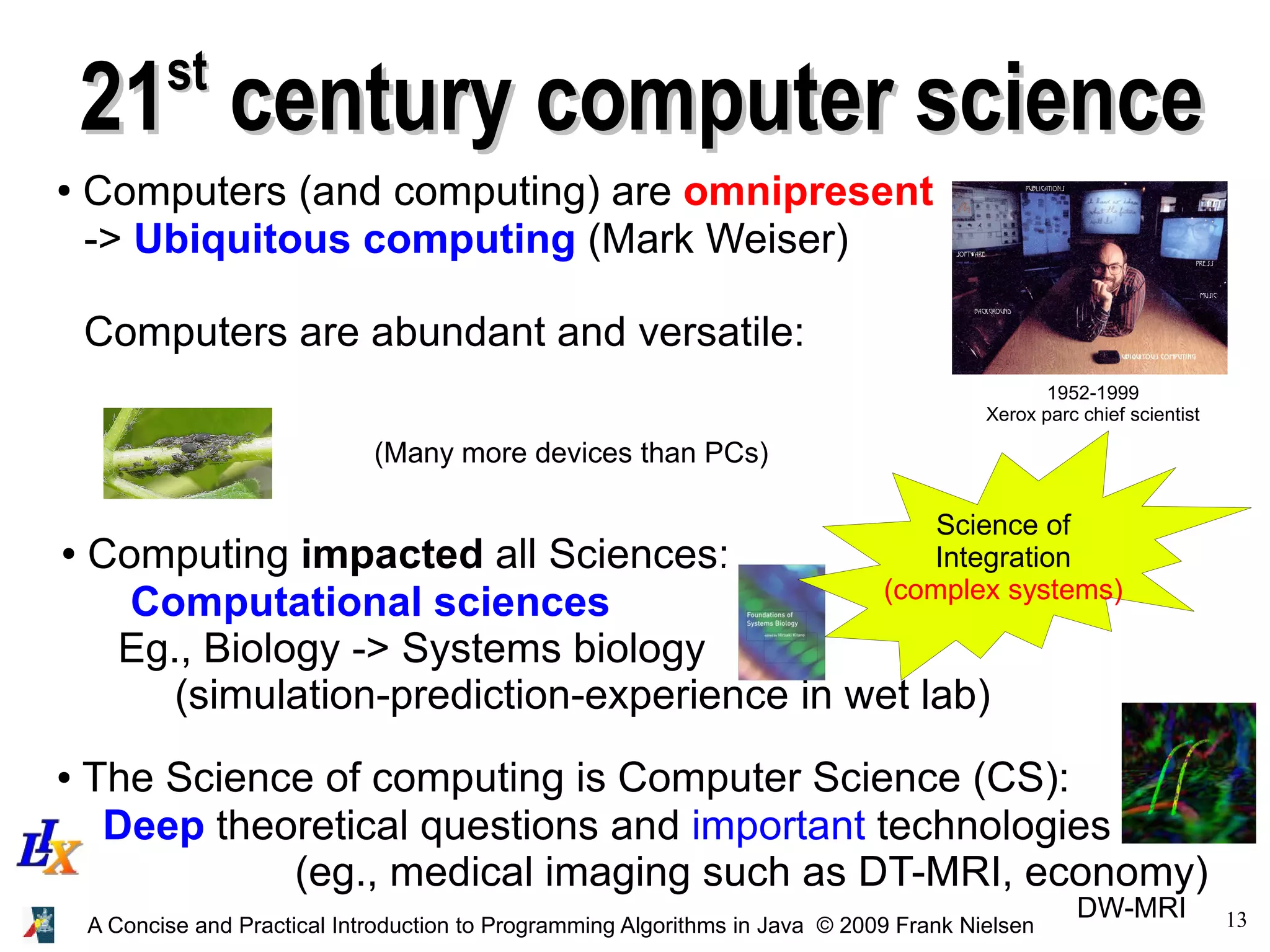
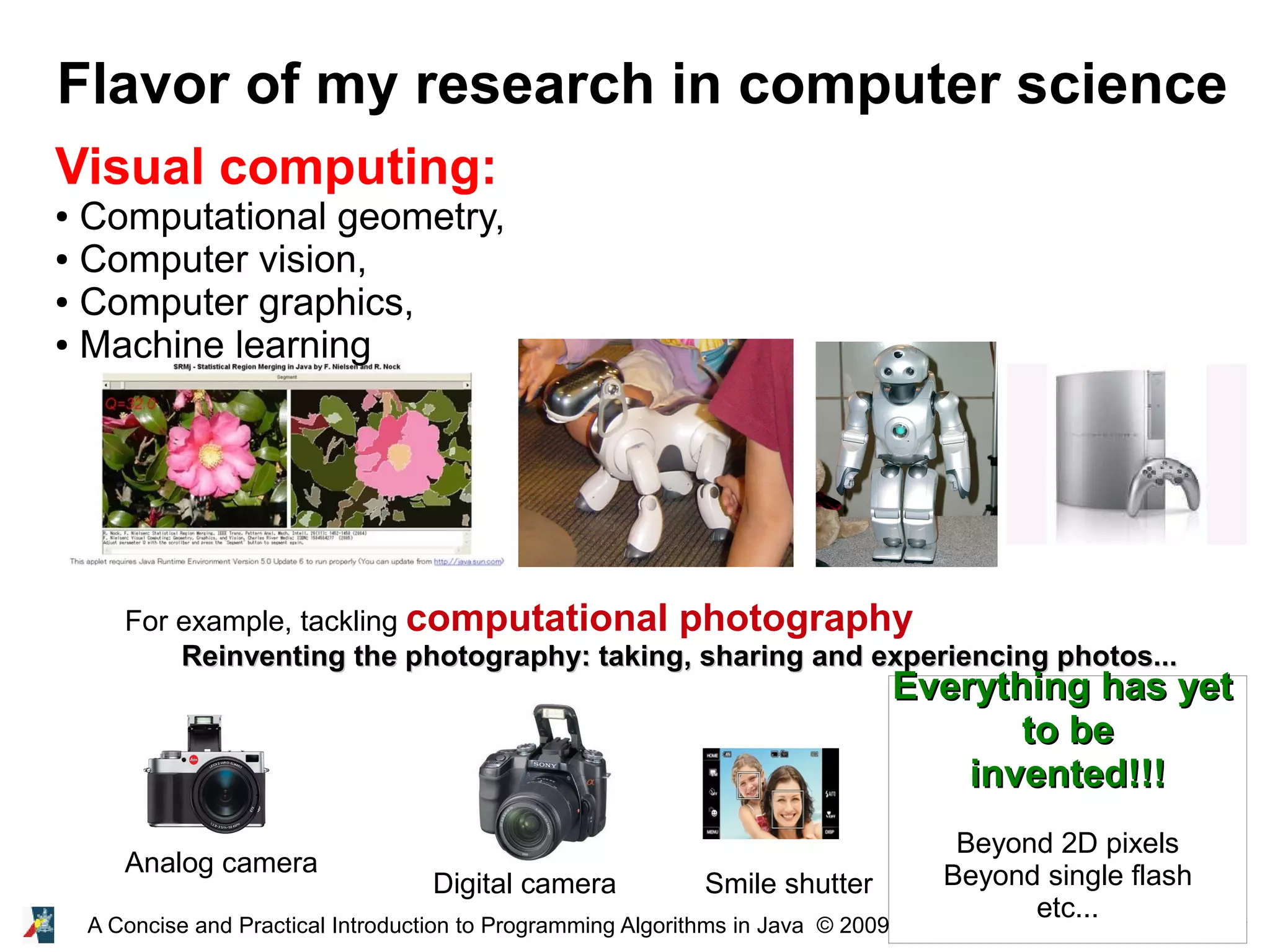
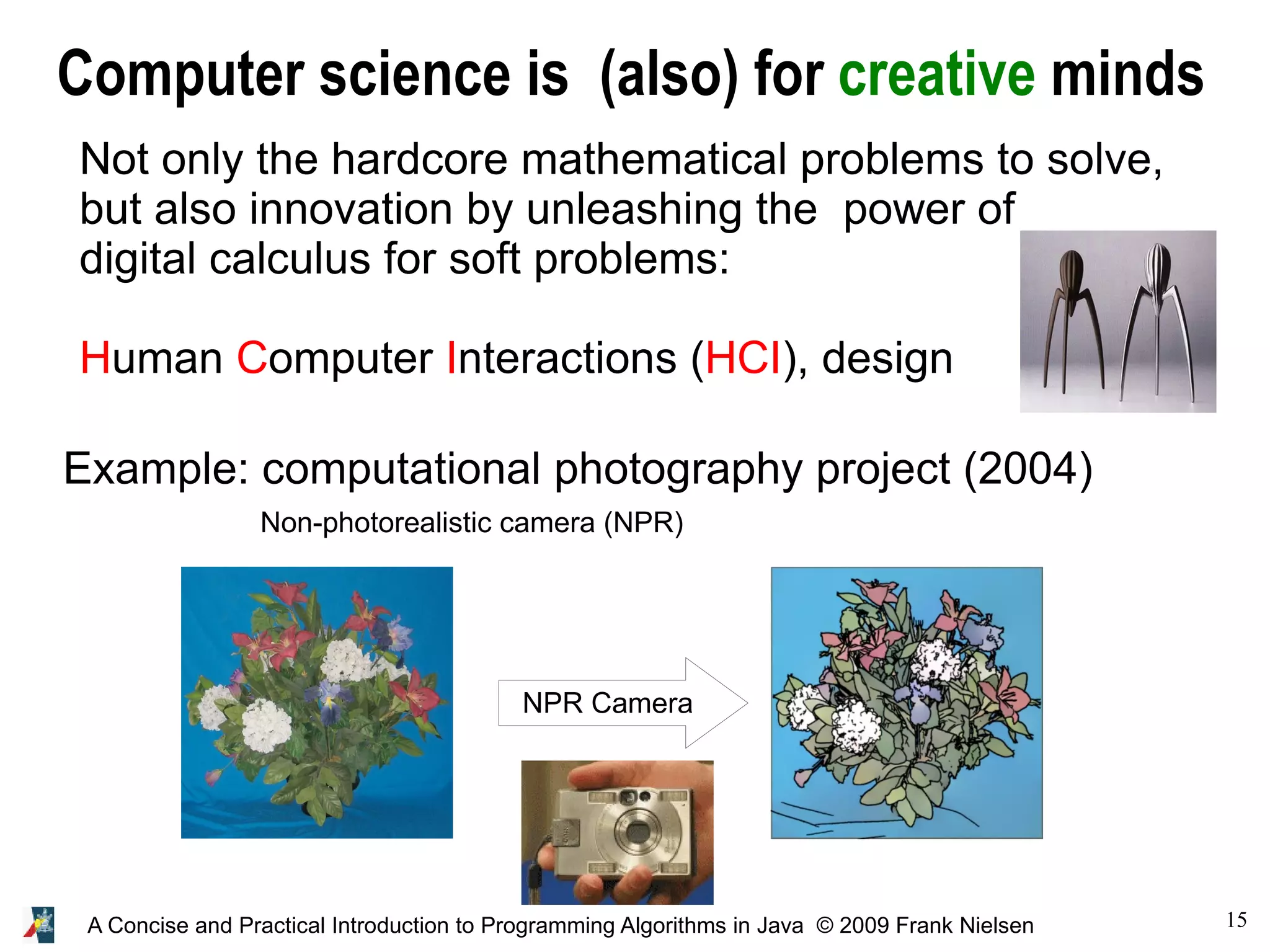
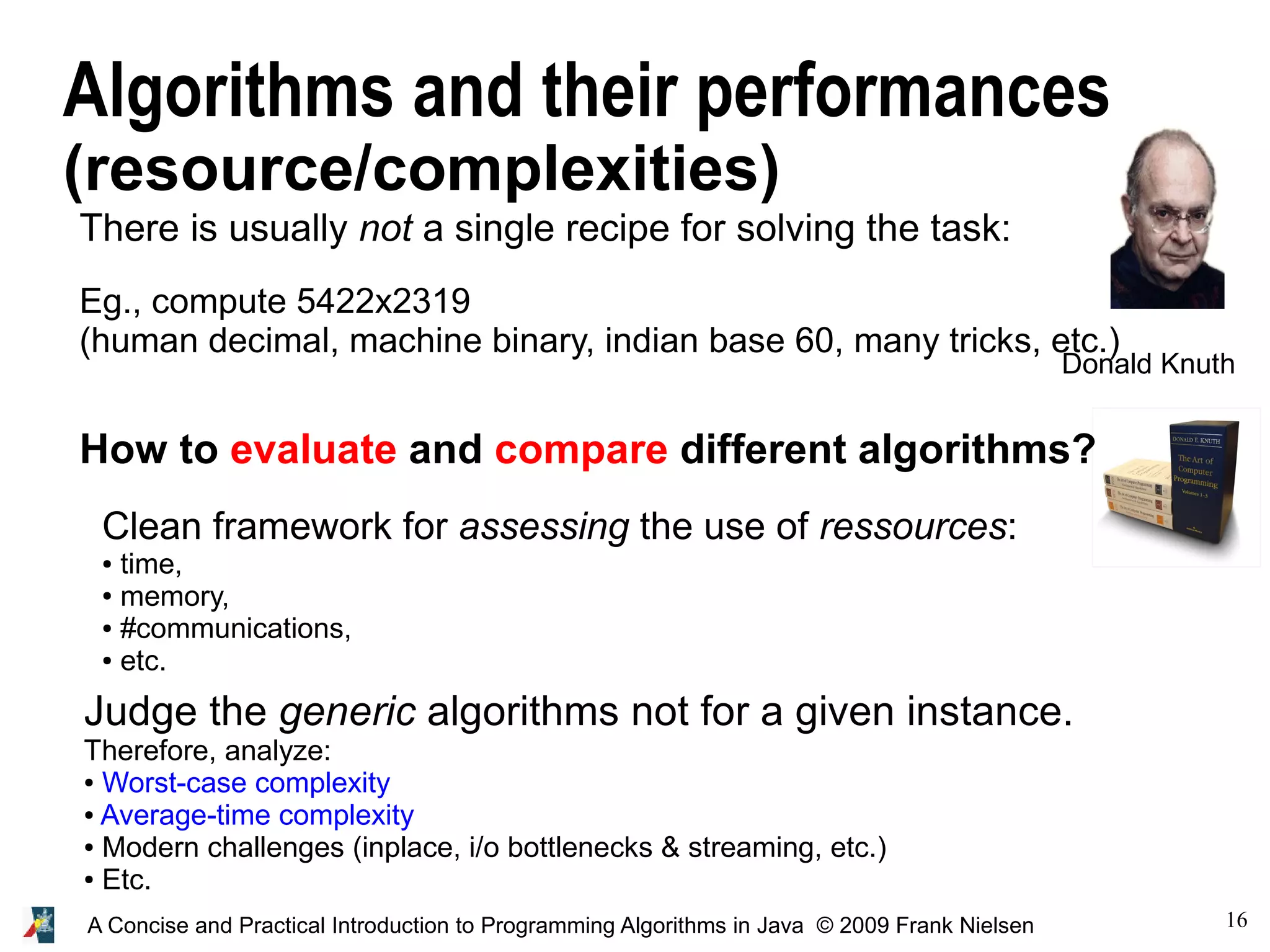
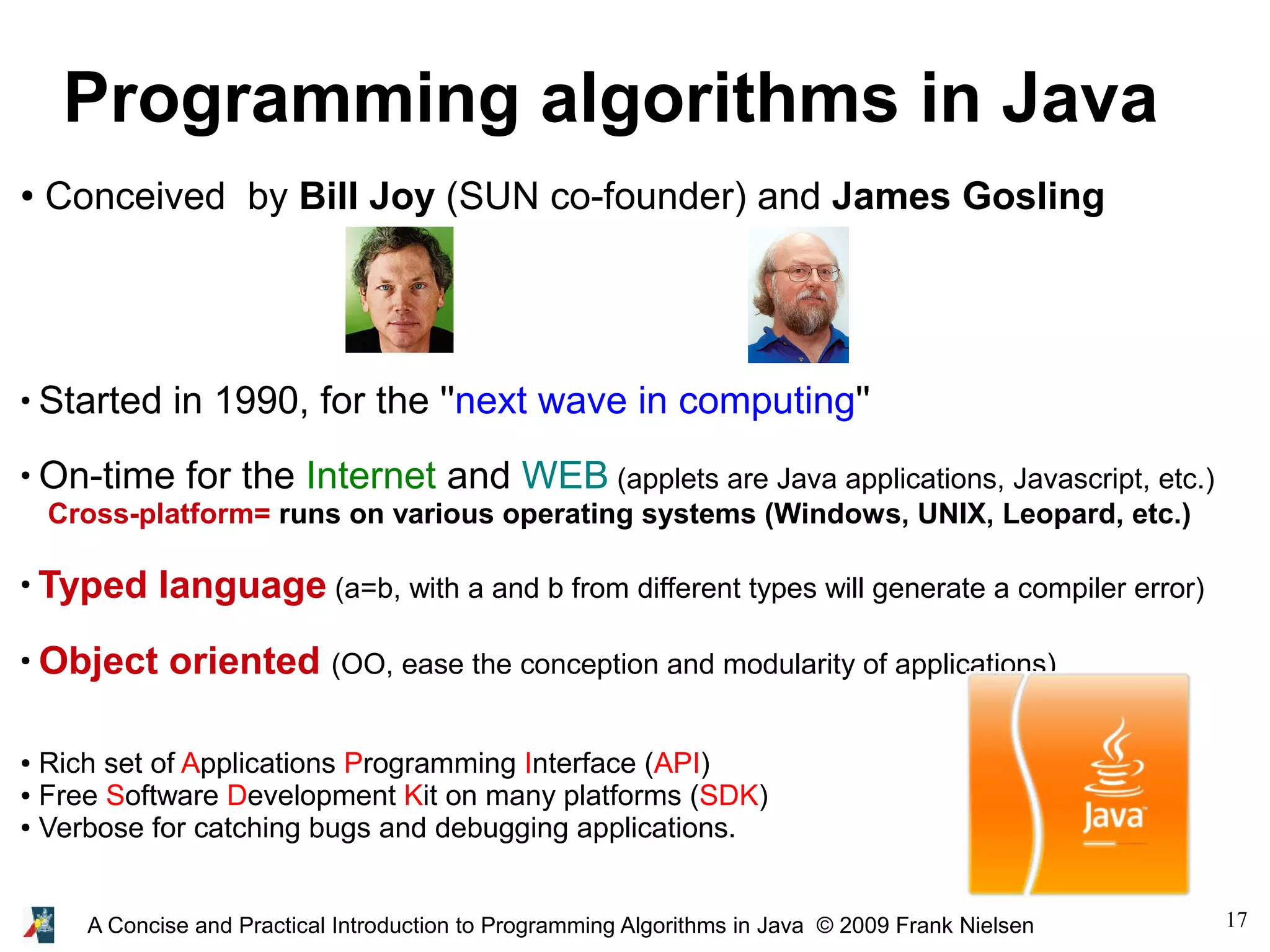
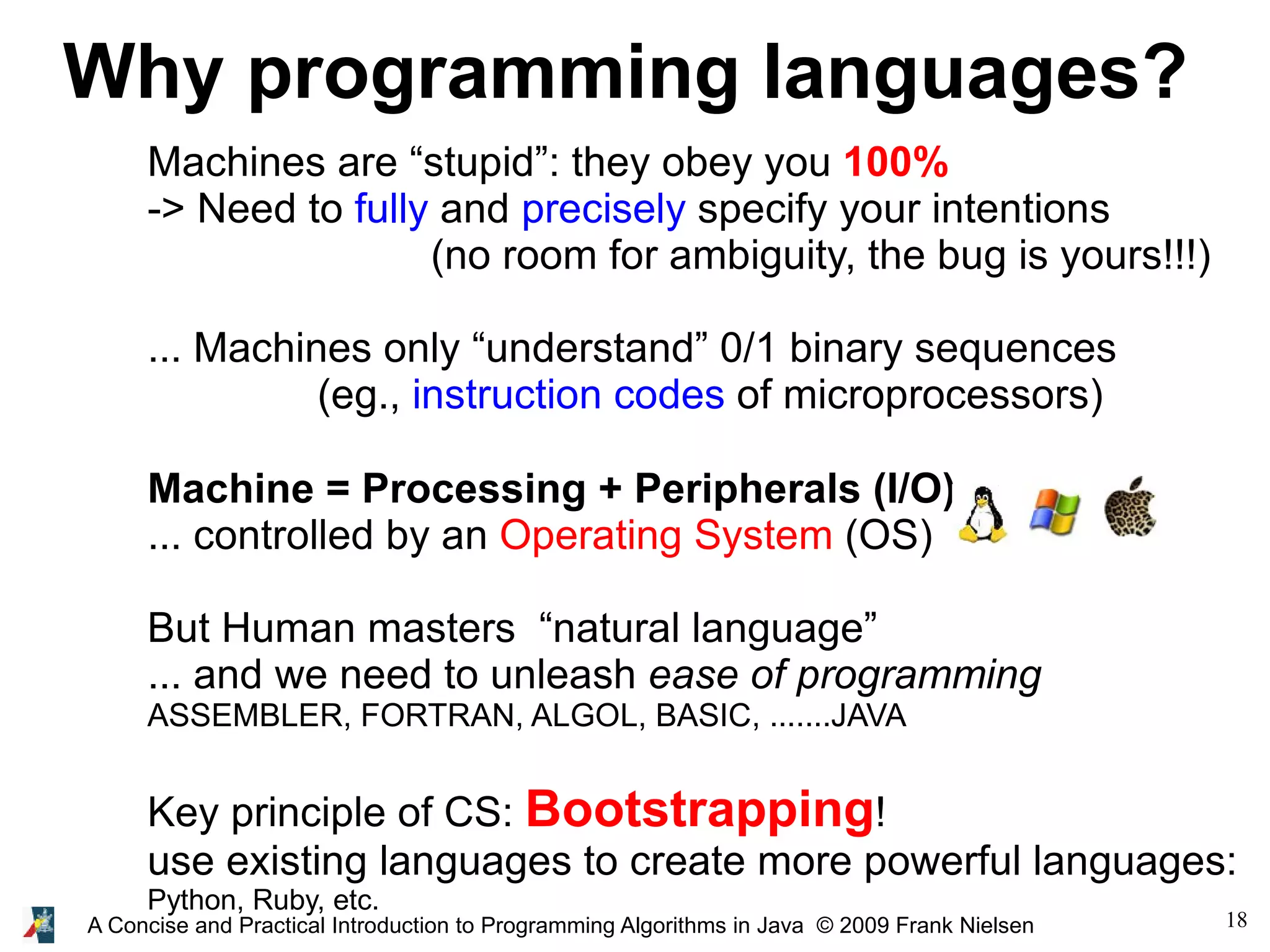
![19A Concise and Practical Introduction to Programming Algorithms in Java © 2009 Frank Nielsen My first (java) program Programmers and CScientists cherrish... ... their “Hello World” programs class FirstProgram{ public static void main (String[ ] args){ System.out.println("Hello INF311 !"); } } First programs often looks magic! Special function main: entry of the program](https://image.slidesharecdn.com/programmingalgorithmsjava-1-140701005144-phpapp02/75/chapter-1-A-Concise-and-Practical-Introduction-to-Programming-Algorithms-in-Java-19-2048.jpg)
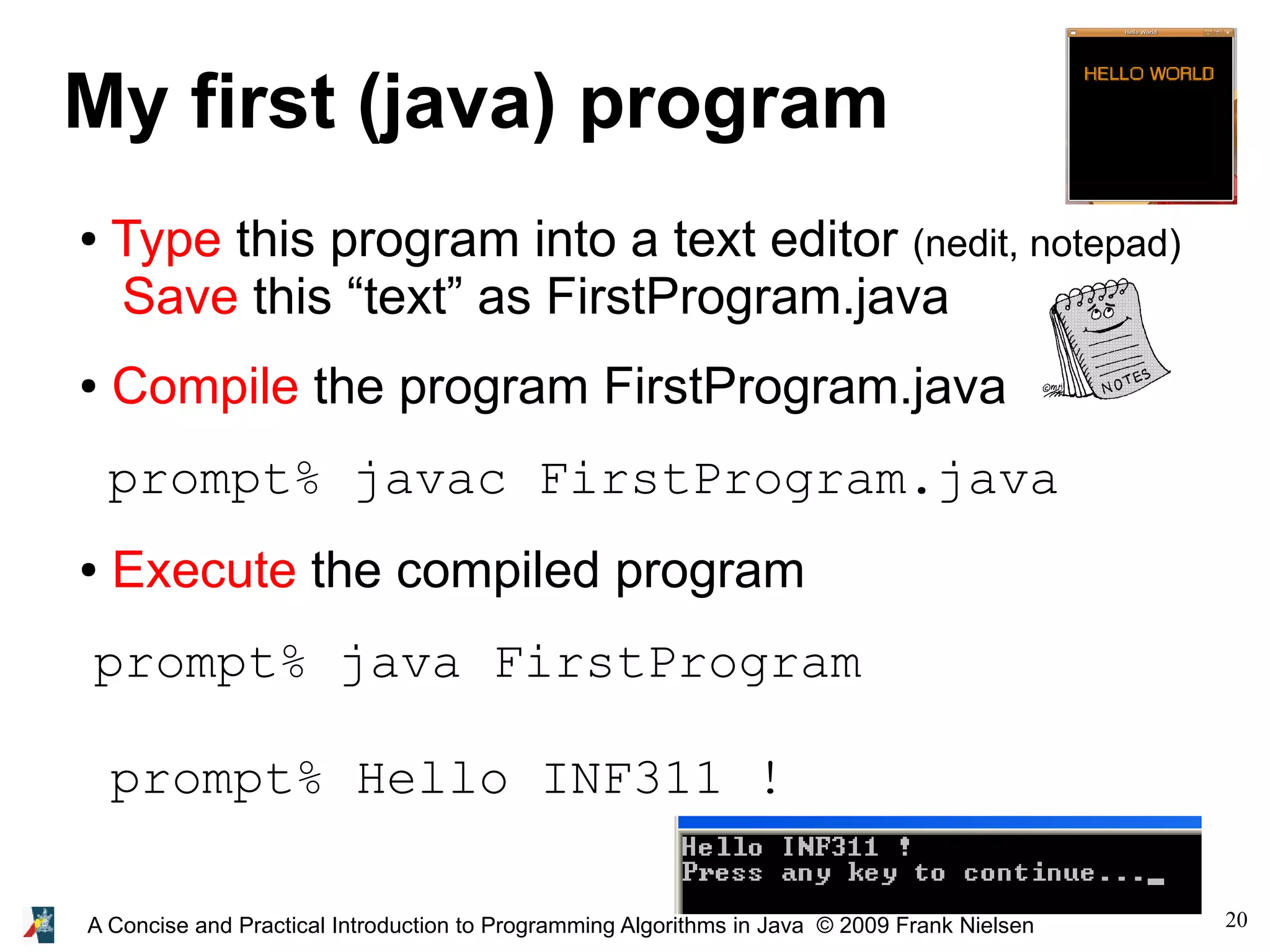
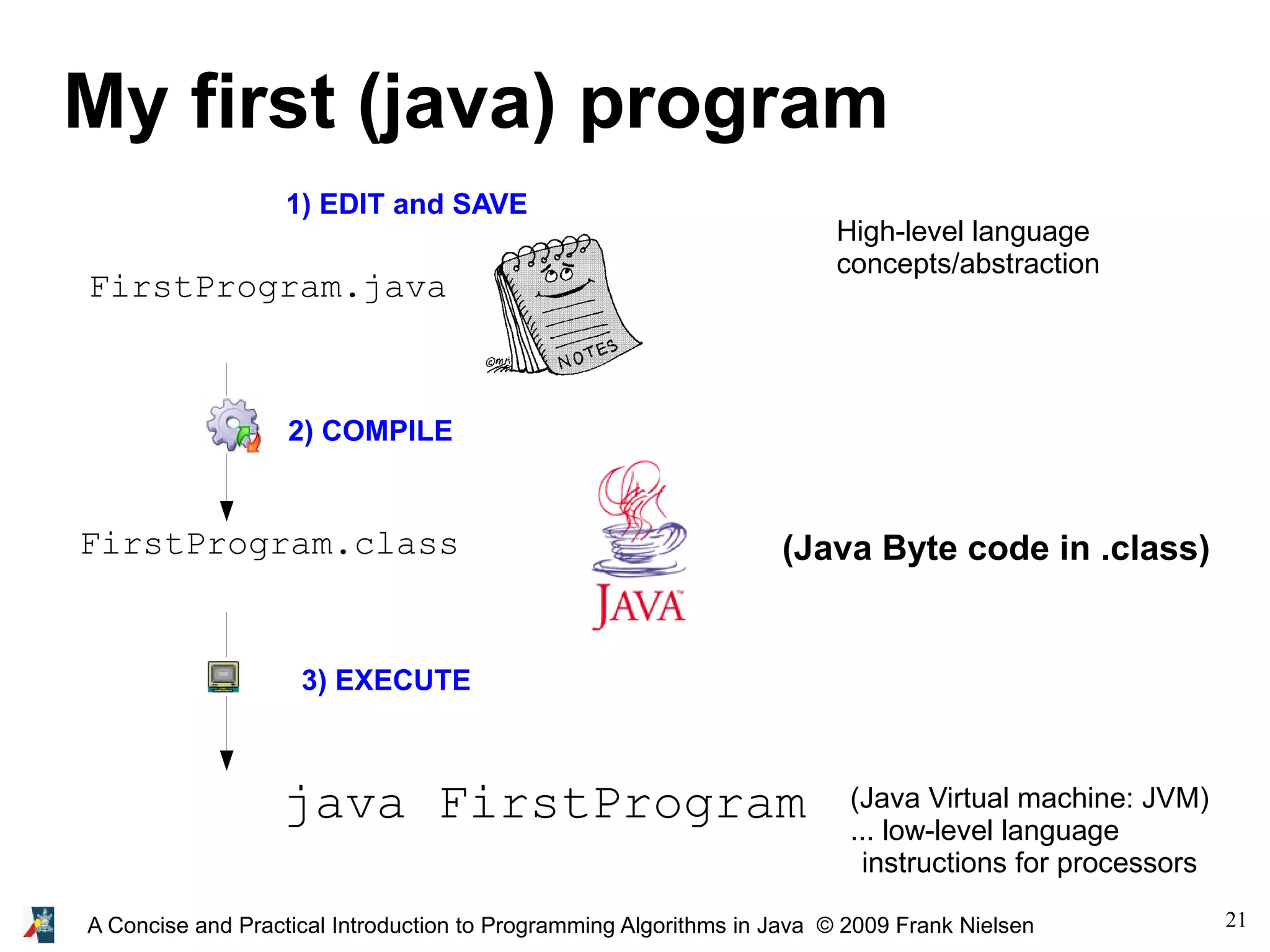
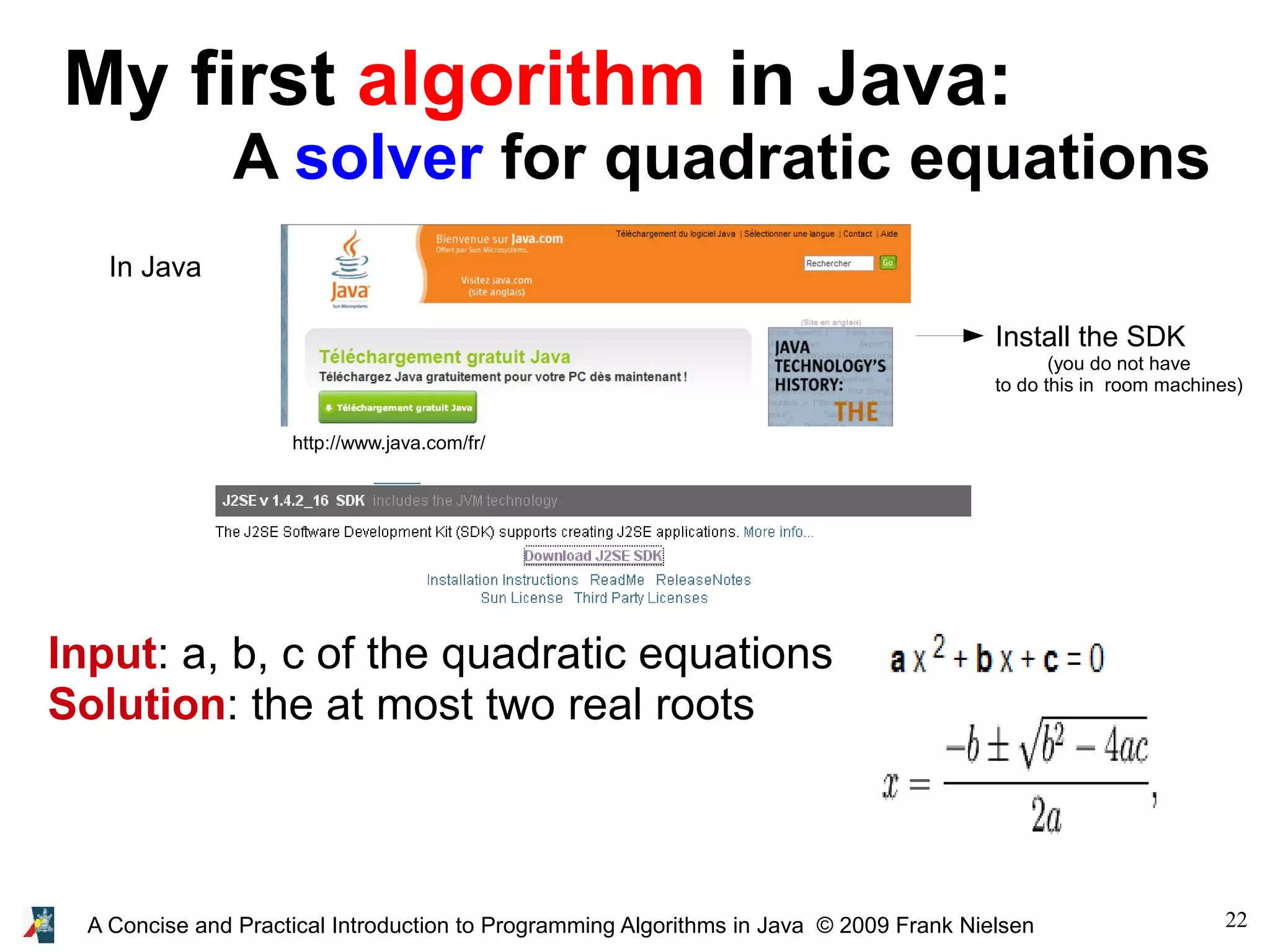
![23A Concise and Practical Introduction to Programming Algorithms in Java © 2009 Frank Nielsen Programming: Solver for quadratic equations class QuadraticEquationSolver { public static void main(String[] arg) { double a,b,c; a=Math.sqrt(3.0); b=2.0; c=-3.0; double delta=b*b-4.0*a*c; double root1, root2; root1= (-b-Math.sqrt(delta))/(2.0*a); root2= (-b+Math.sqrt(delta))/(2.0*a); System.out.println(root1); System.out.println(root2); System.out.println("Let us check the roots:"); System.out.println(a*root1*root1+b*root1+c); System.out.println(a*root2*root2+b*root2+c); } } QuadraticEquationSolver.java](https://image.slidesharecdn.com/programmingalgorithmsjava-1-140701005144-phpapp02/75/chapter-1-A-Concise-and-Practical-Introduction-to-Programming-Algorithms-in-Java-23-2048.jpg)
![24A Concise and Practical Introduction to Programming Algorithms in Java © 2009 Frank Nielsen class QuadraticEquationSolver { public static void main(String[] arg) { double a,b,c; a=Math.sqrt(3.0); b=2.0; c=-3.0; double delta=b*b-4.0*a*c; double root1, root2; root1= (-b-Math.sqrt(delta))/(2.0*a); root2= (-b+Math.sqrt(delta))/(2.0*a); System.out.println(root1); System.out.println(root2); System.out.println("Let us check the roots:"); System.out.println(a*root1*root1+b*root1+c); System.out.println(a*root2*root2+b*root2+c); } } Programming simple formula Variable (declare) Assignments Declare+Assign](https://image.slidesharecdn.com/programmingalgorithmsjava-1-140701005144-phpapp02/75/chapter-1-A-Concise-and-Practical-Introduction-to-Programming-Algorithms-in-Java-24-2048.jpg)
![25A Concise and Practical Introduction to Programming Algorithms in Java © 2009 Frank Nielsen class QuadraticEquationSolver { public static void main(String[] arg) { double a,b,c; a=Math.sqrt(3.0); b=2.0; c=-3.0; double delta=b*b-4.0*a*c; double root1, root2; root1= (-b-Math.sqrt(delta))/(2.0*a); root2= (-b+Math.sqrt(delta))/(2.0*a); System.out.println(root1); System.out.println(root2); System.out.println("Let us check the roots:"); System.out.println(a*root1*root1+b*root1+c); System.out.println(a*root2*root2+b*root2+c); } } Programming simple formula Arithmetic expressions Display](https://image.slidesharecdn.com/programmingalgorithmsjava-1-140701005144-phpapp02/75/chapter-1-A-Concise-and-Practical-Introduction-to-Programming-Algorithms-in-Java-25-2048.jpg)
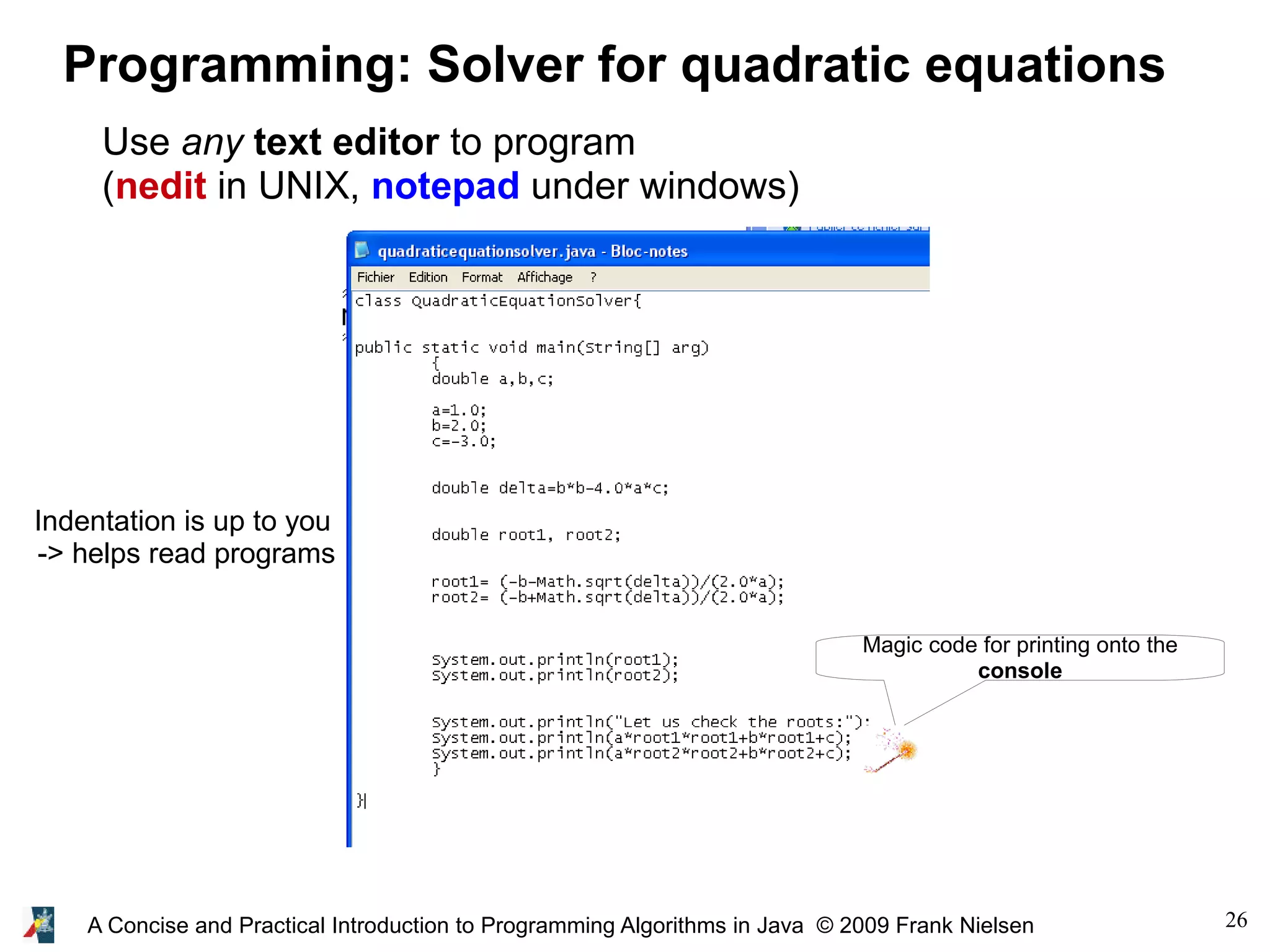
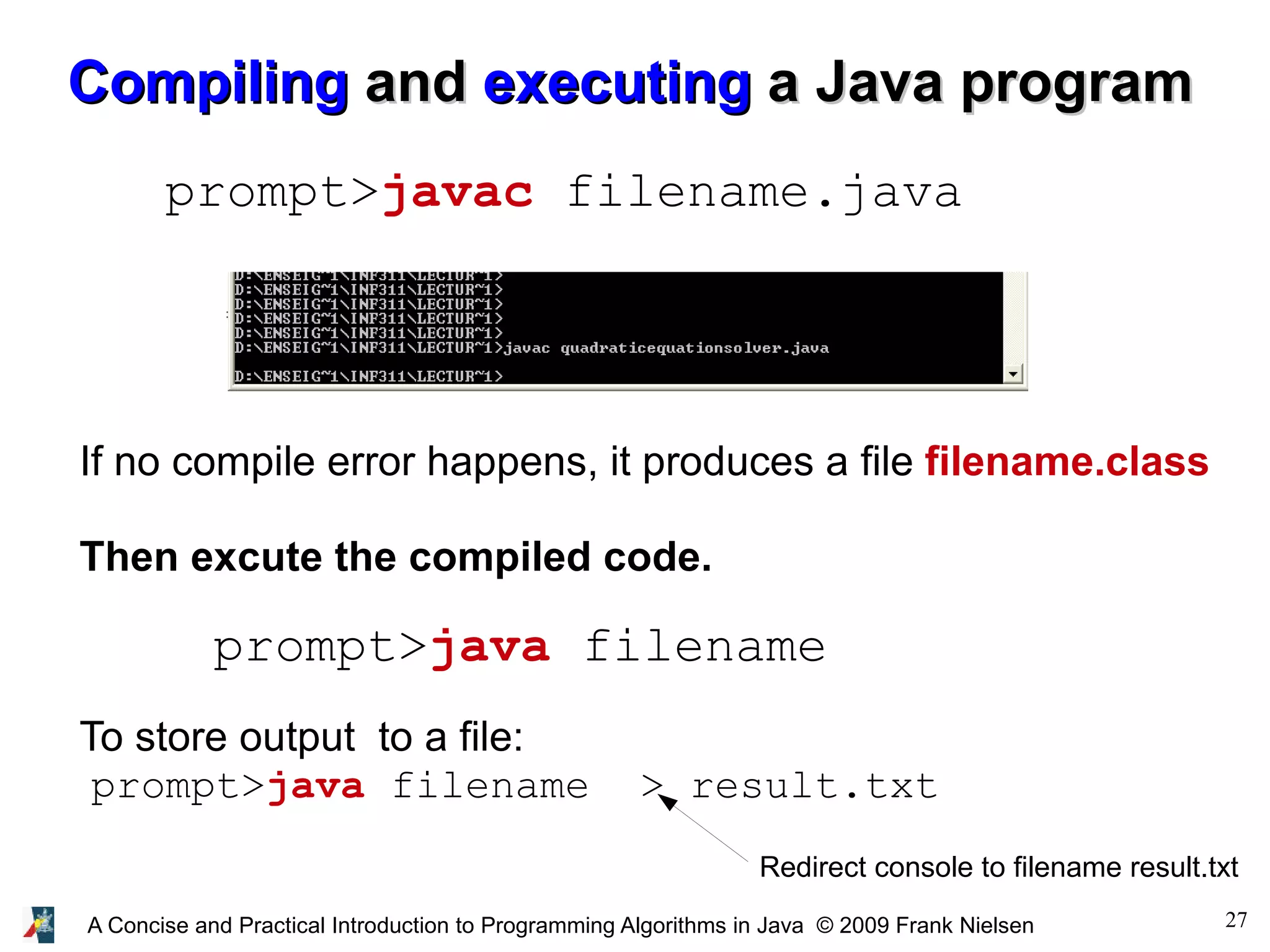
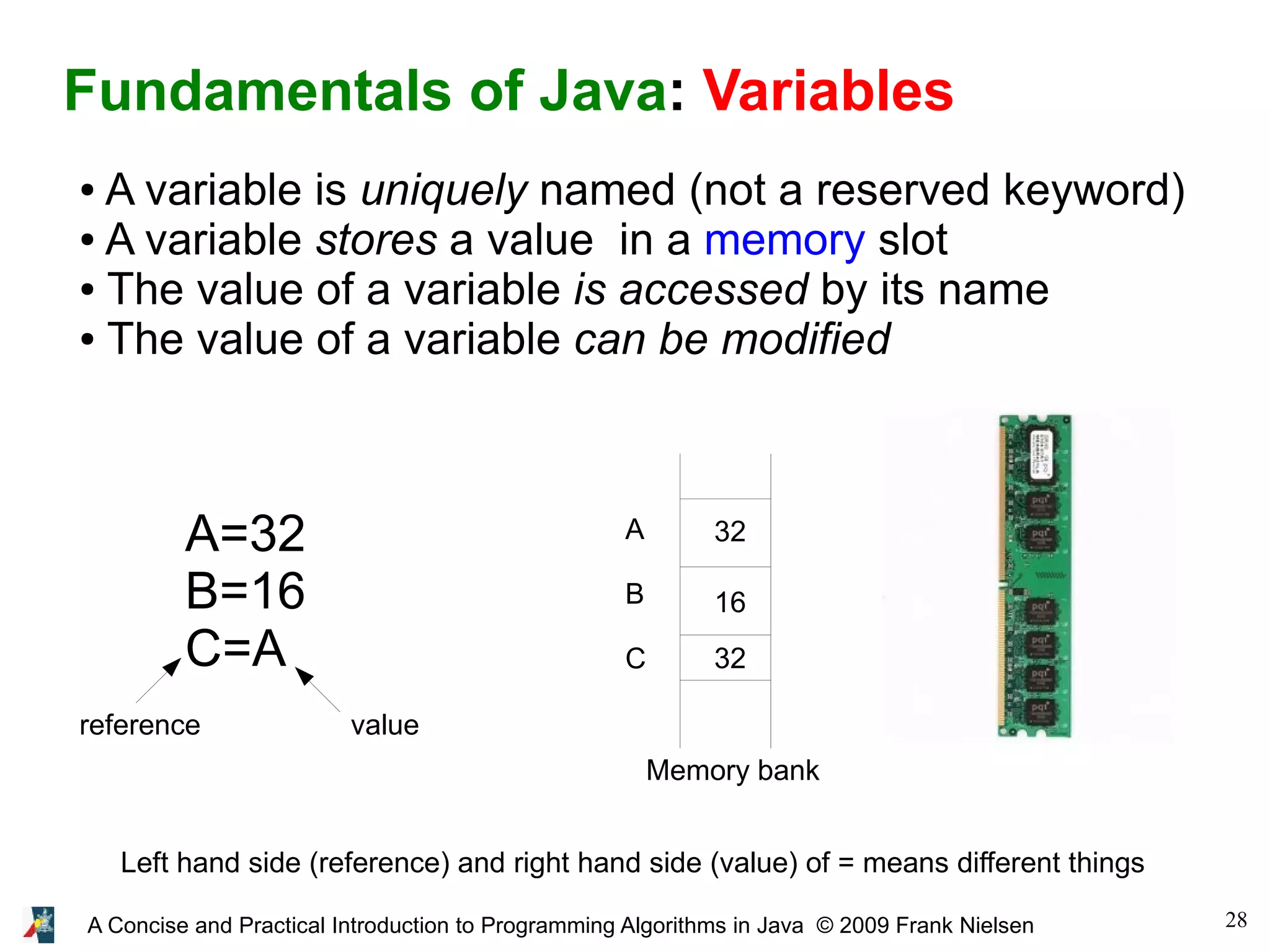
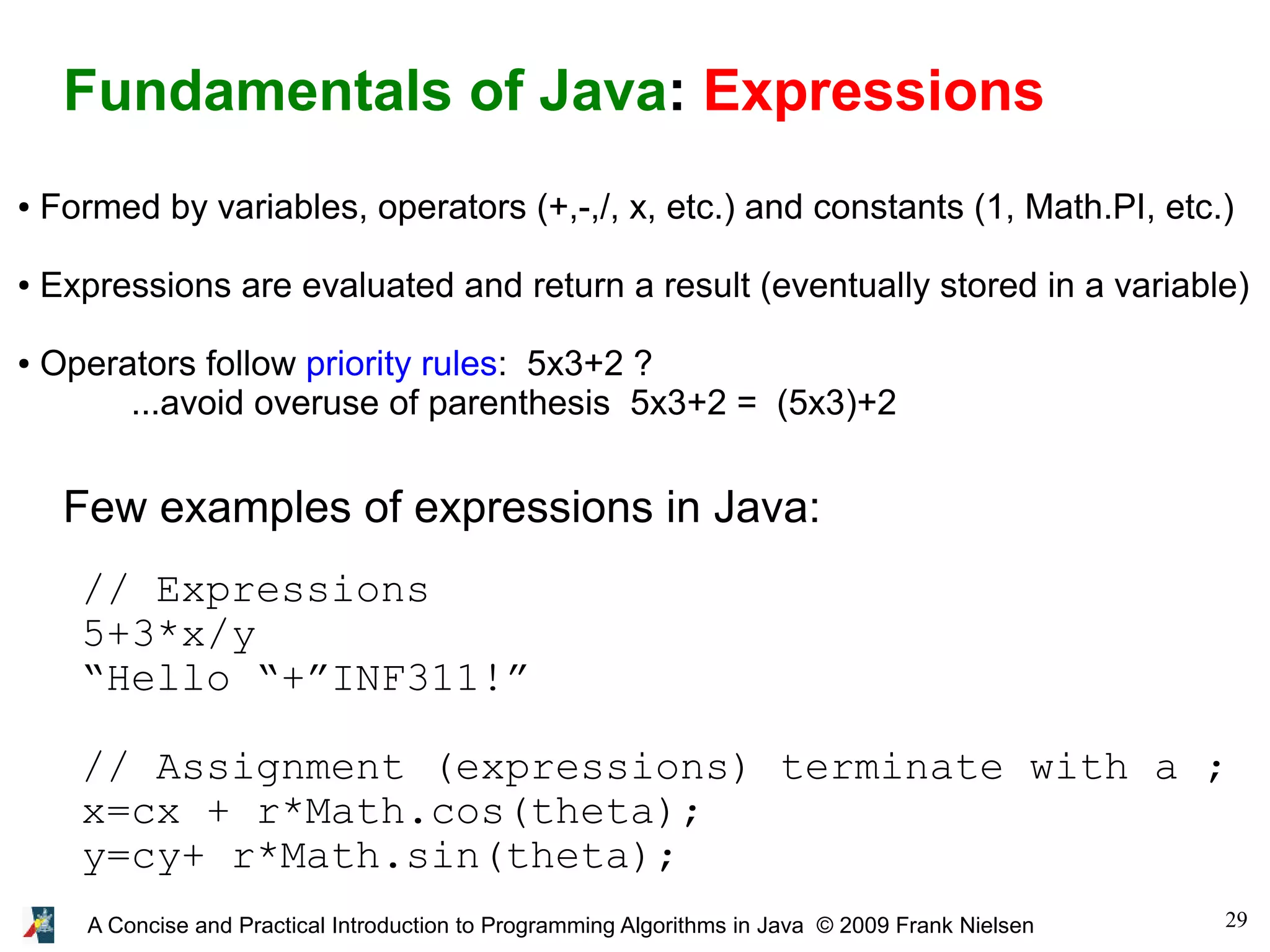
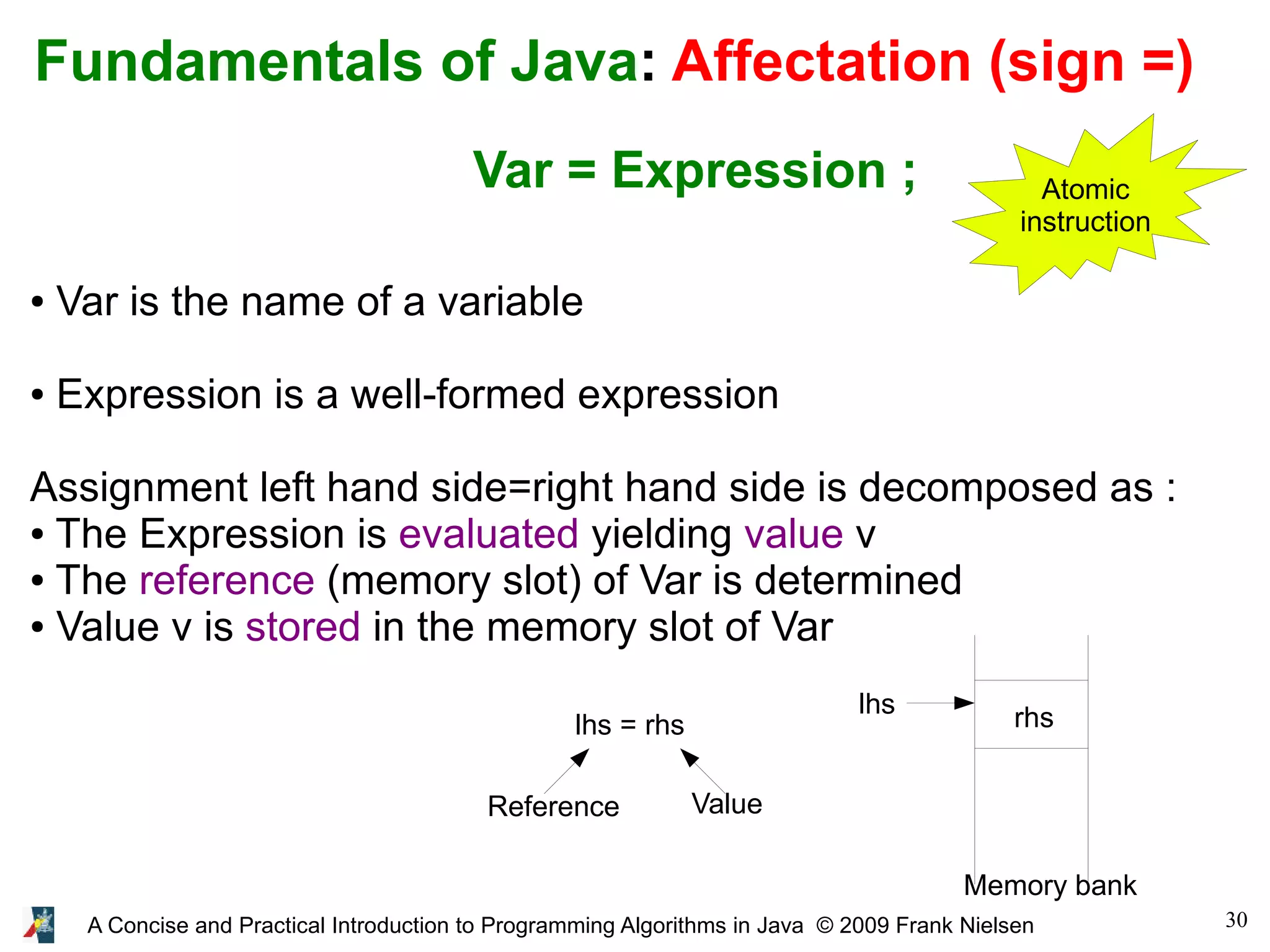
![31A Concise and Practical Introduction to Programming Algorithms in Java © 2009 Frank Nielsen Basic typesBasic types Type = Domain of values of variables All variables must be typed in JavaAll variables must be typed in Java Basic types (=basic data structures): Integers: byte 8 bits short 16 bits int 32 bits [-2**31,2**31-1] long 64 bits [-2**63,2**63-1] Reals: float (single precision, 32 bits) double (double precision, 64 bits) char 16 bits (Unicode, world languages) boolean true or false](https://image.slidesharecdn.com/programmingalgorithmsjava-1-140701005144-phpapp02/75/chapter-1-A-Concise-and-Practical-Introduction-to-Programming-Algorithms-in-Java-31-2048.jpg)
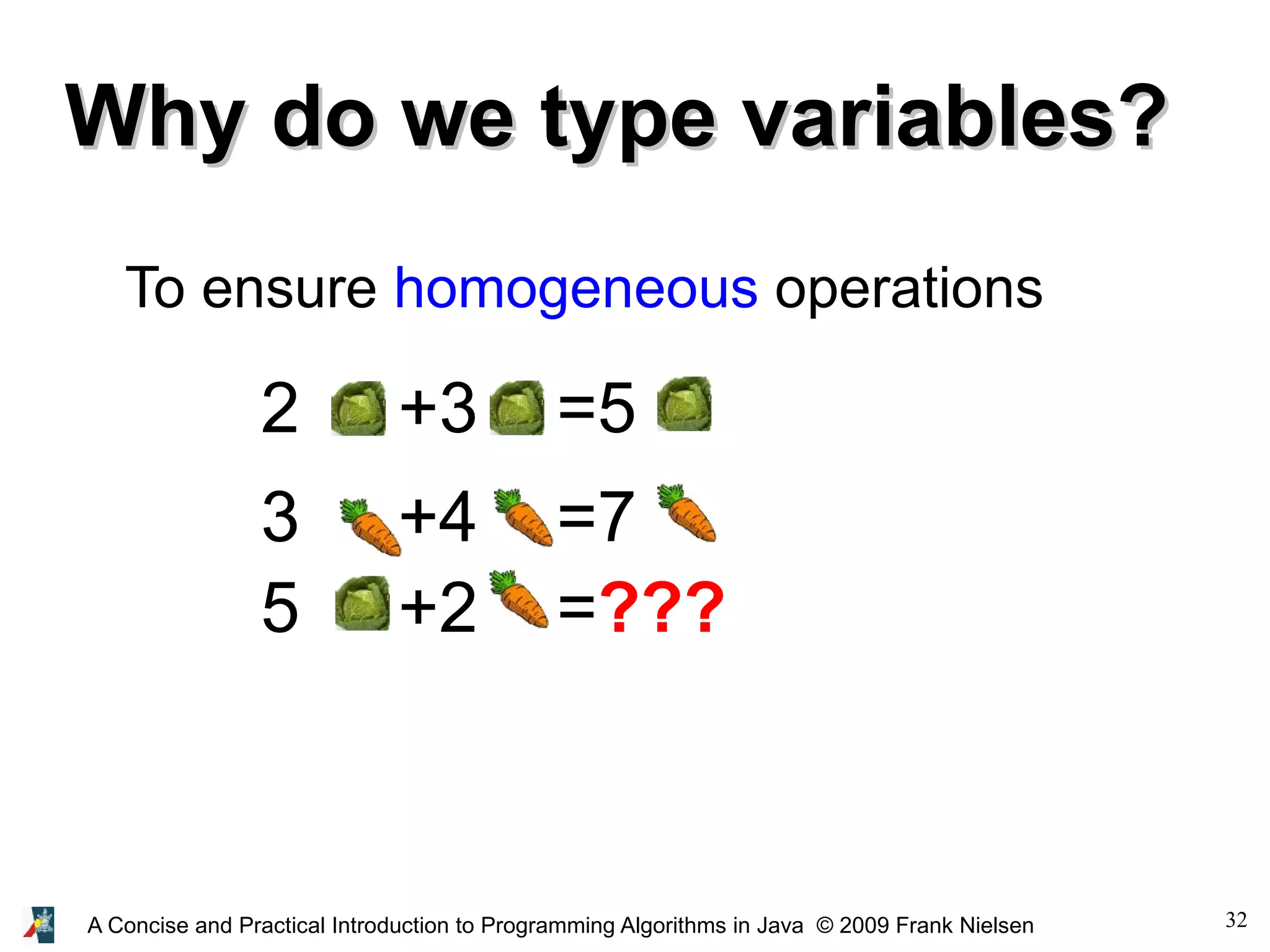
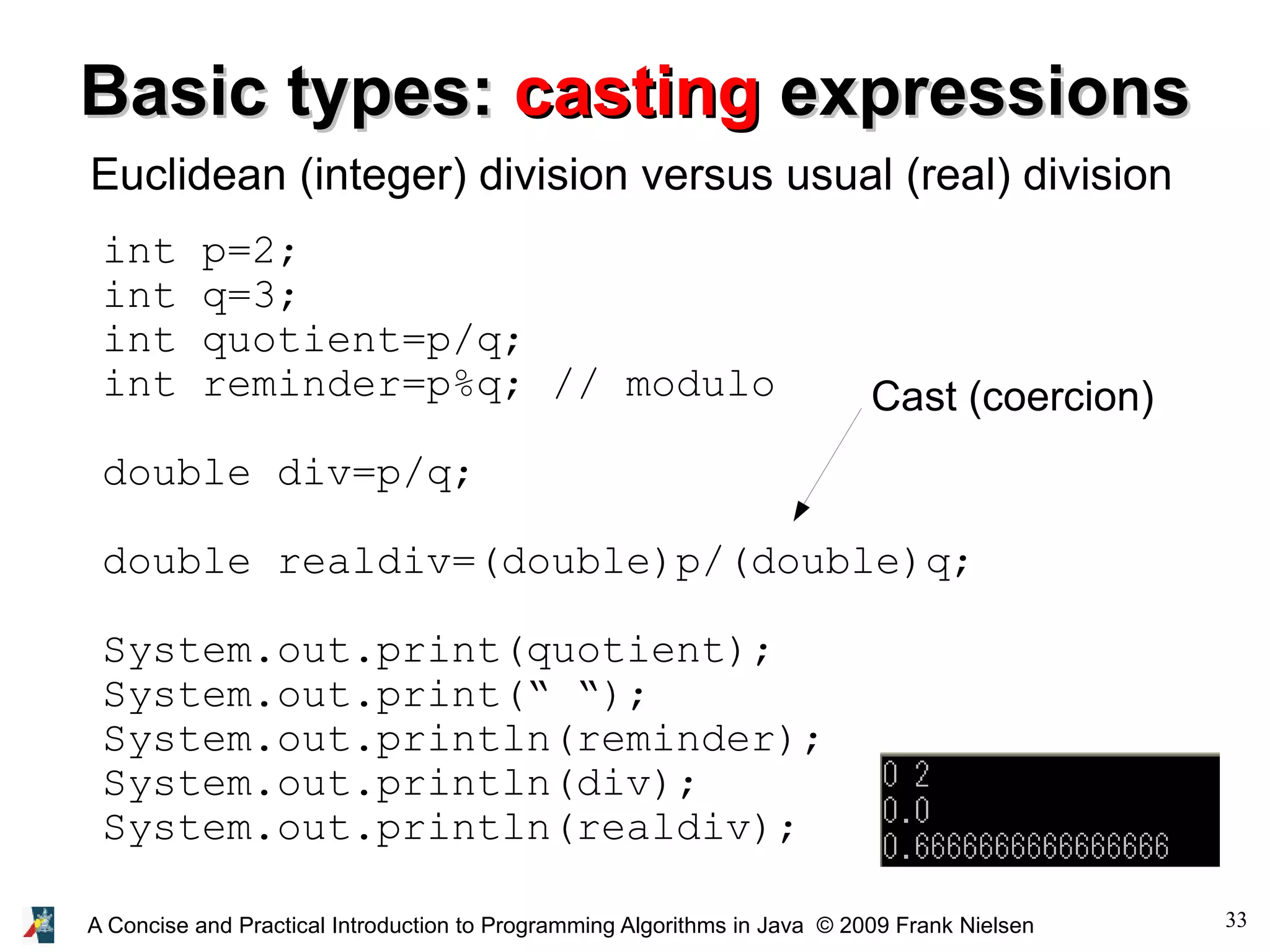
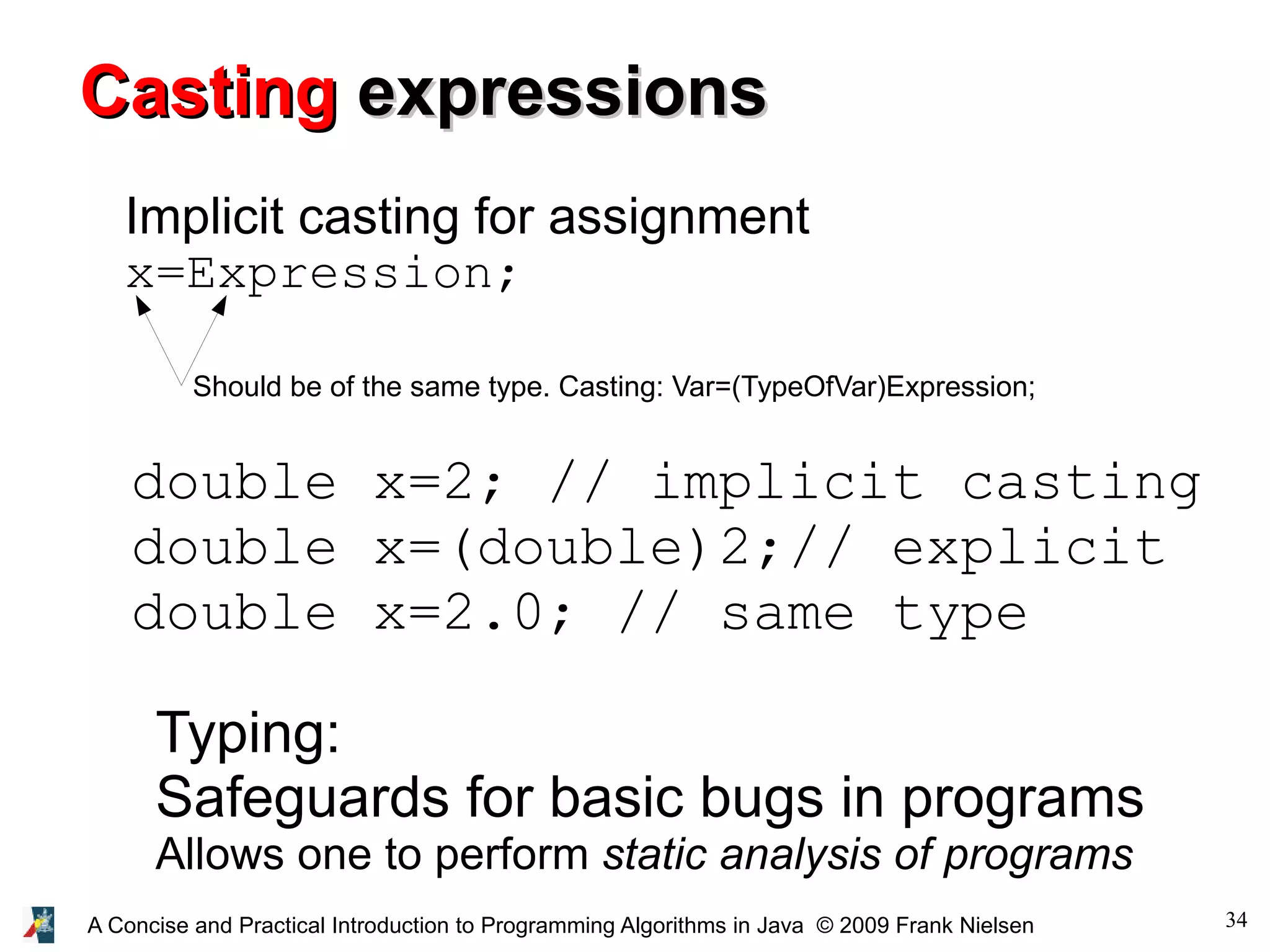
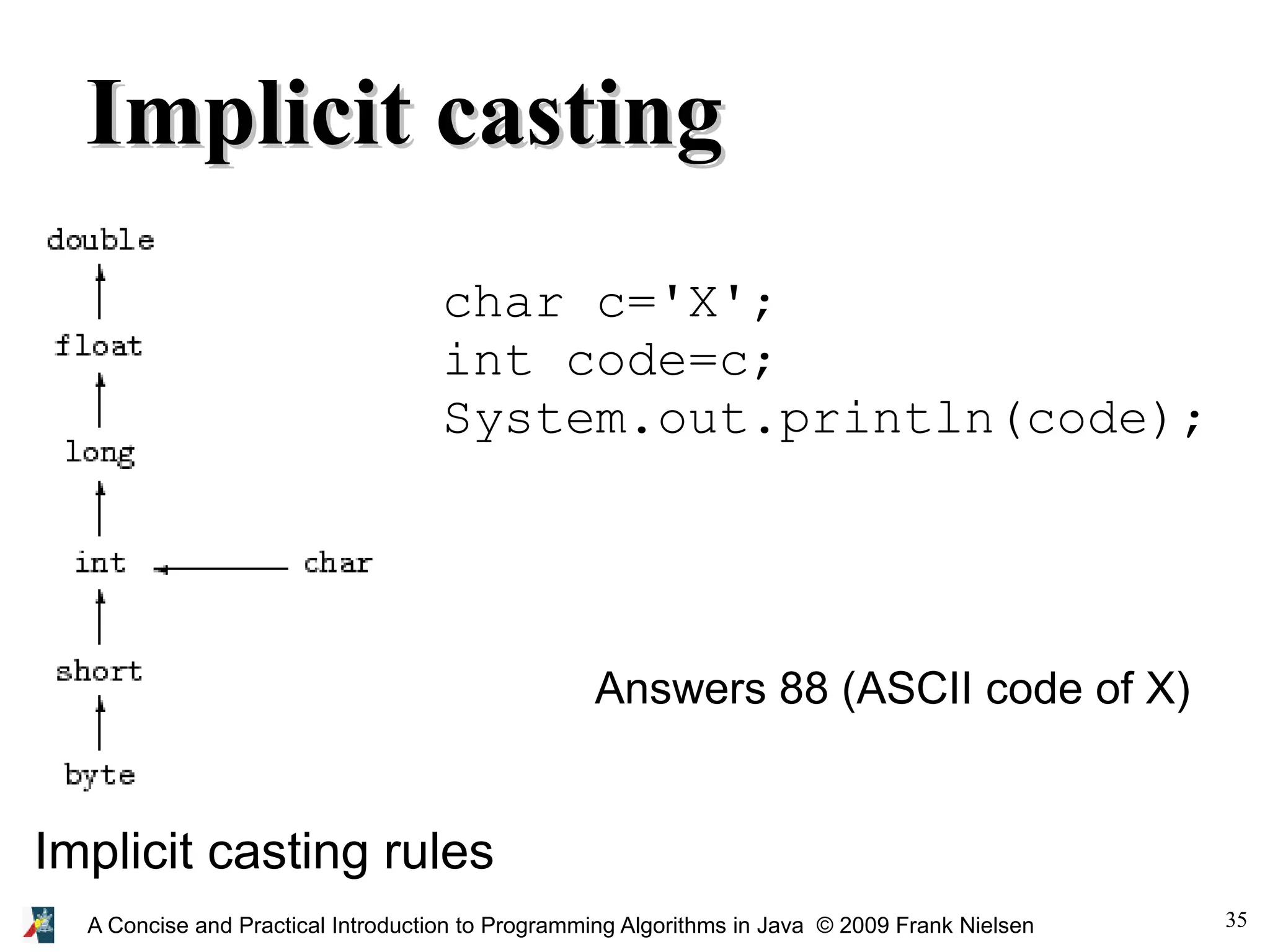
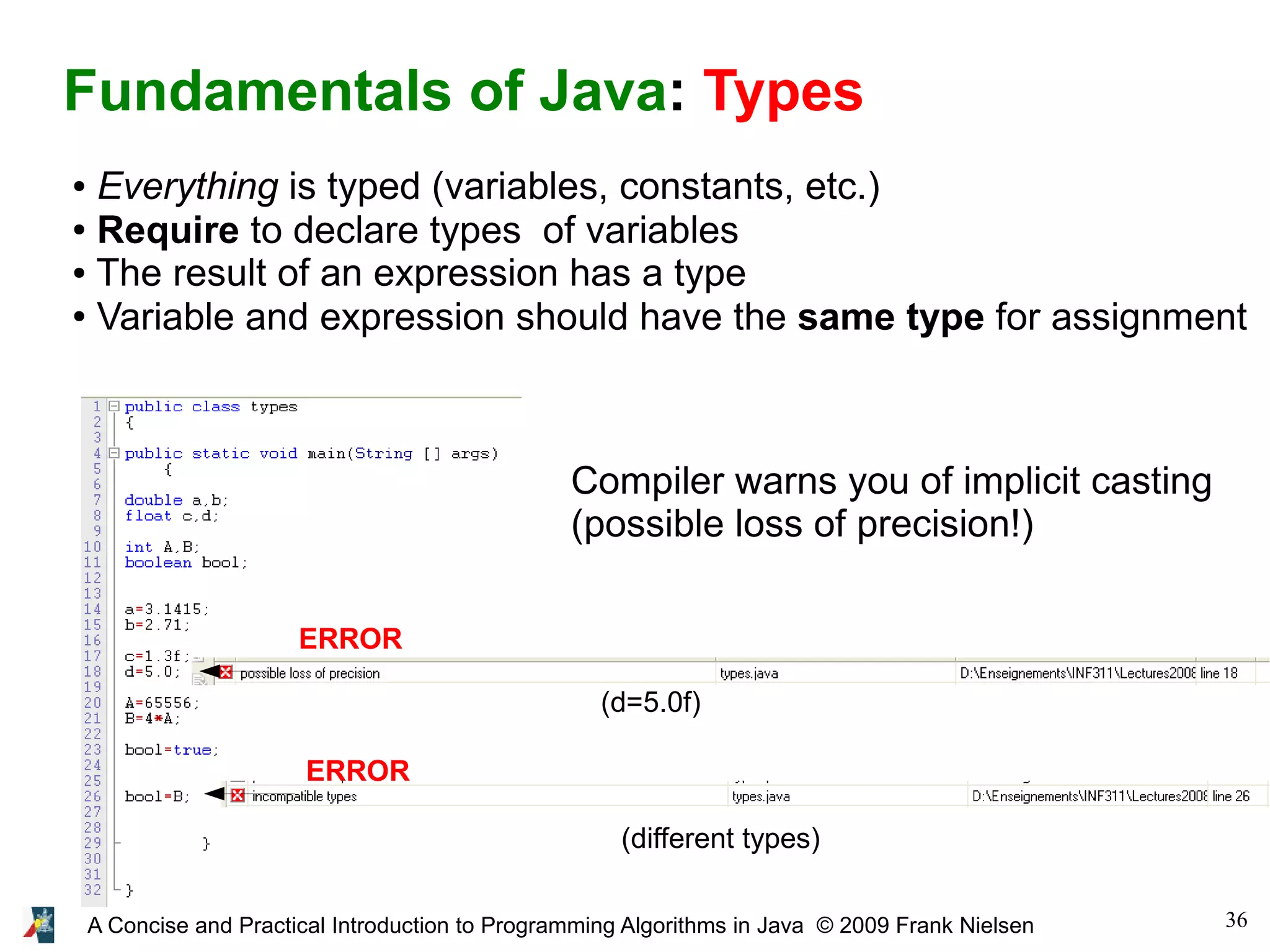
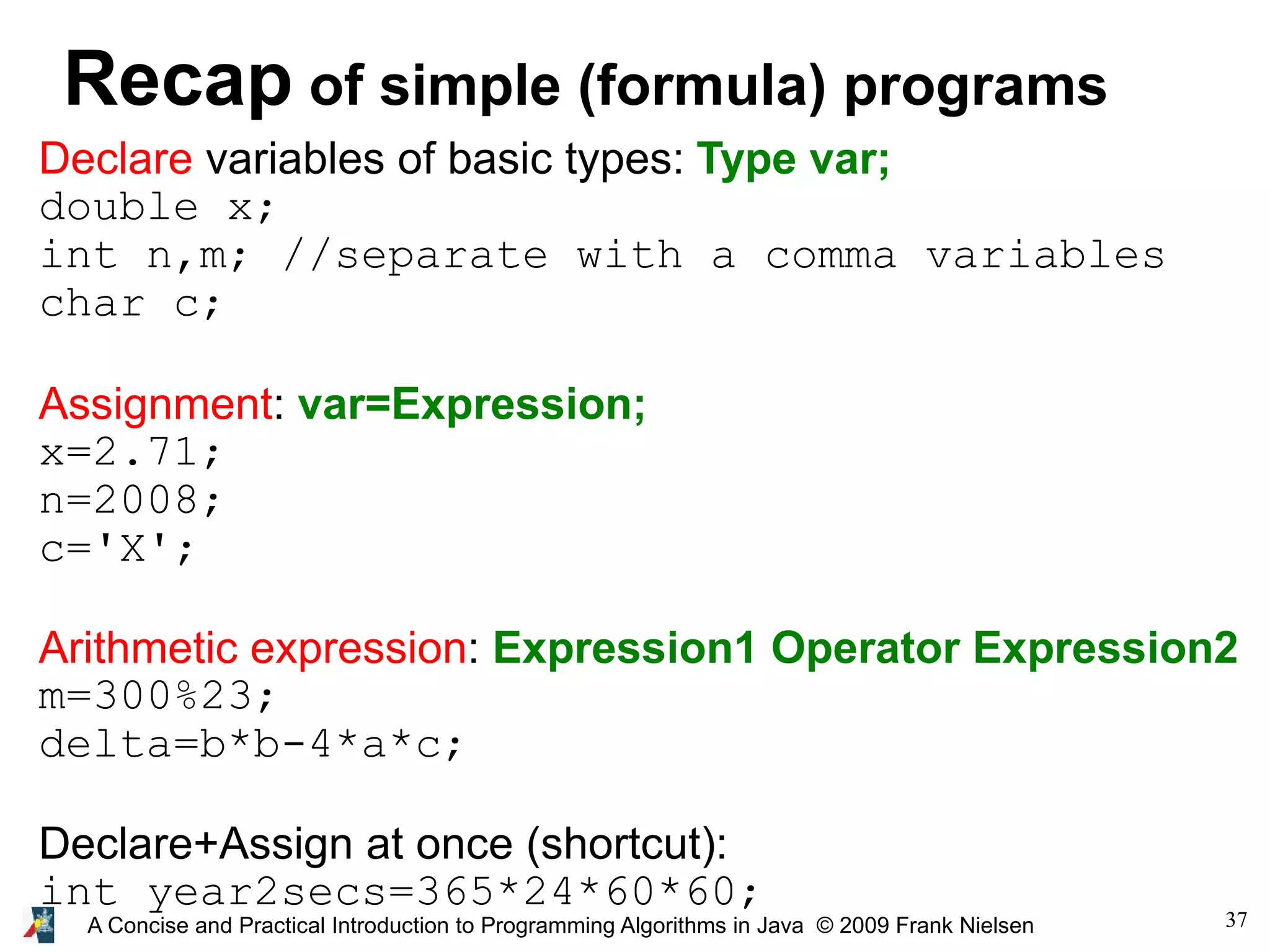
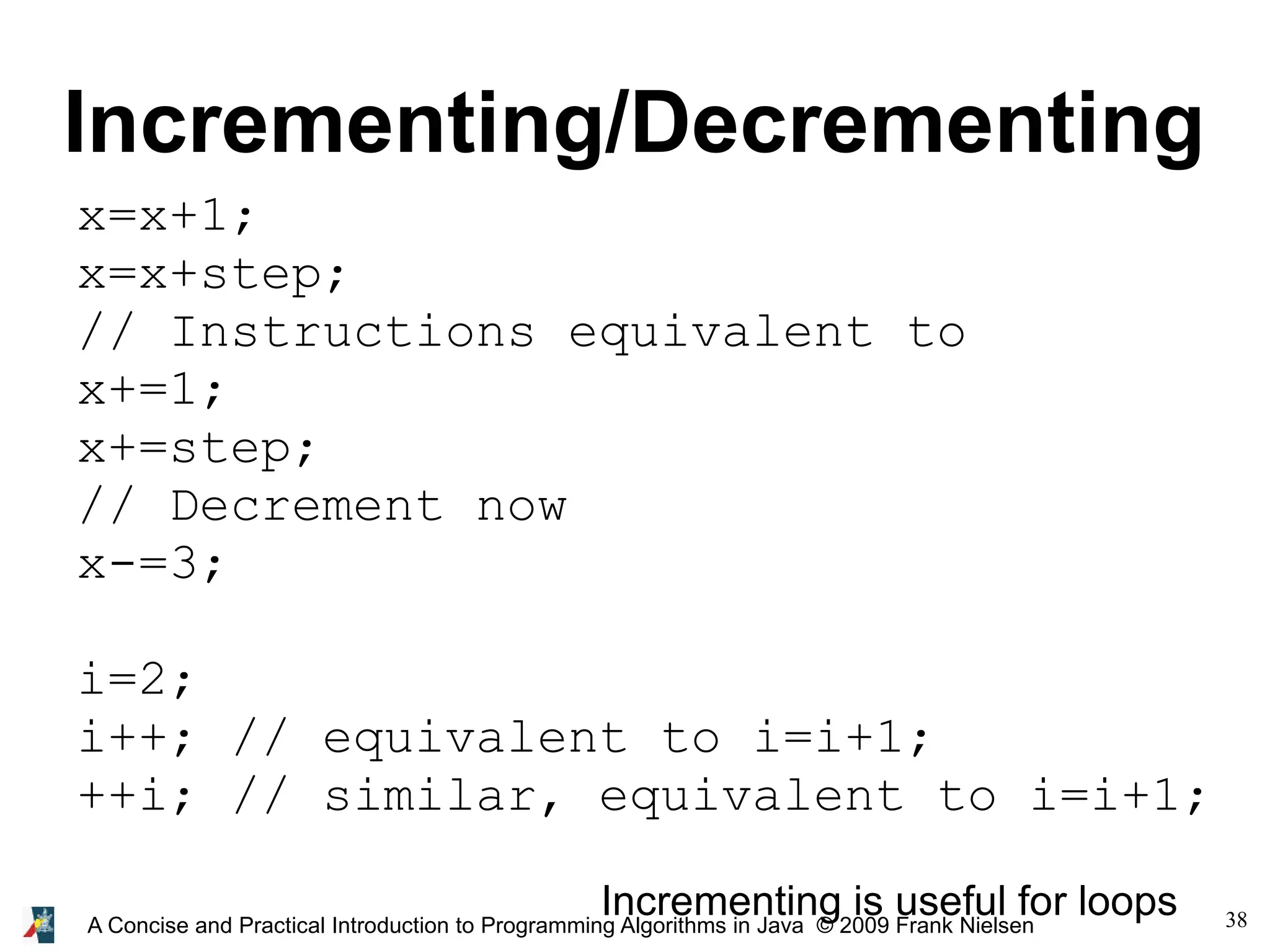
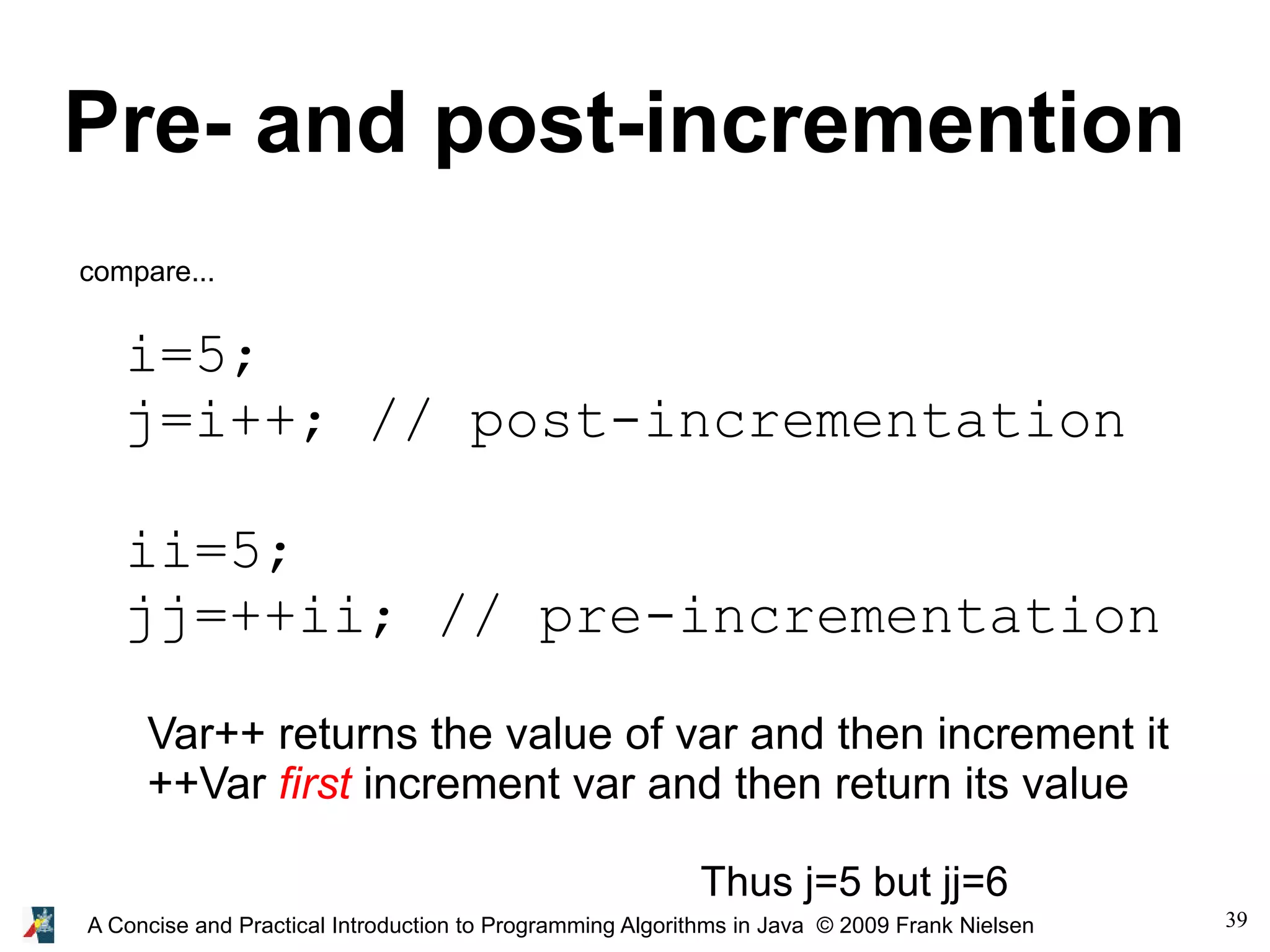
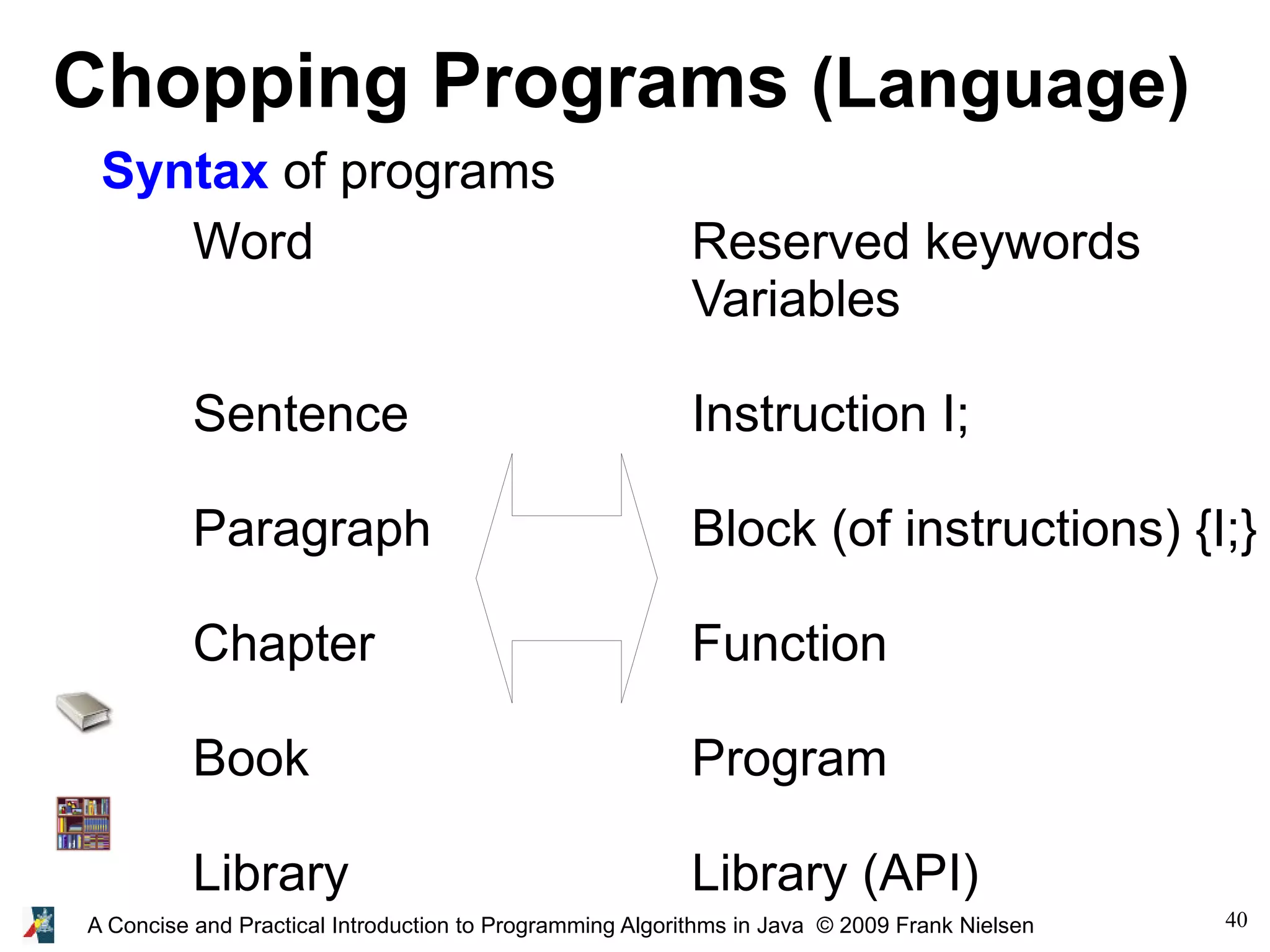
![41A Concise and Practical Introduction to Programming Algorithms in Java © 2009 Frank Nielsen Commenting programs ● Adopt conventions Eg., class ClassName .... stored in file ClassName.java ● Name variables explicitly (so that you can remember them easily) ● Comment programs (single line // or multiple lines /* */) // Written for INF311 class CommentProgram { /* This is a simple Java program that illustrates how to comment source code */ // Entry of the program public static void main(String[ ] args) {// it does nothing } }](https://image.slidesharecdn.com/programmingalgorithmsjava-1-140701005144-phpapp02/75/chapter-1-A-Concise-and-Practical-Introduction-to-Programming-Algorithms-in-Java-41-2048.jpg)
![42A Concise and Practical Introduction to Programming Algorithms in Java © 2009 Frank Nielsen A basic skeleton program in Java Name of your program: Prog.java Magic formula 2 Magic formula 1 > javac Prog.java (builds a Prog.class file) > java Prog (execute the program) 2008 // Basic skeleton program for INF311 class Prog { public static void main(String[] arg) { int x=2008; System.out.println(x); } }](https://image.slidesharecdn.com/programmingalgorithmsjava-1-140701005144-phpapp02/75/chapter-1-A-Concise-and-Practical-Introduction-to-Programming-Algorithms-in-Java-42-2048.jpg)
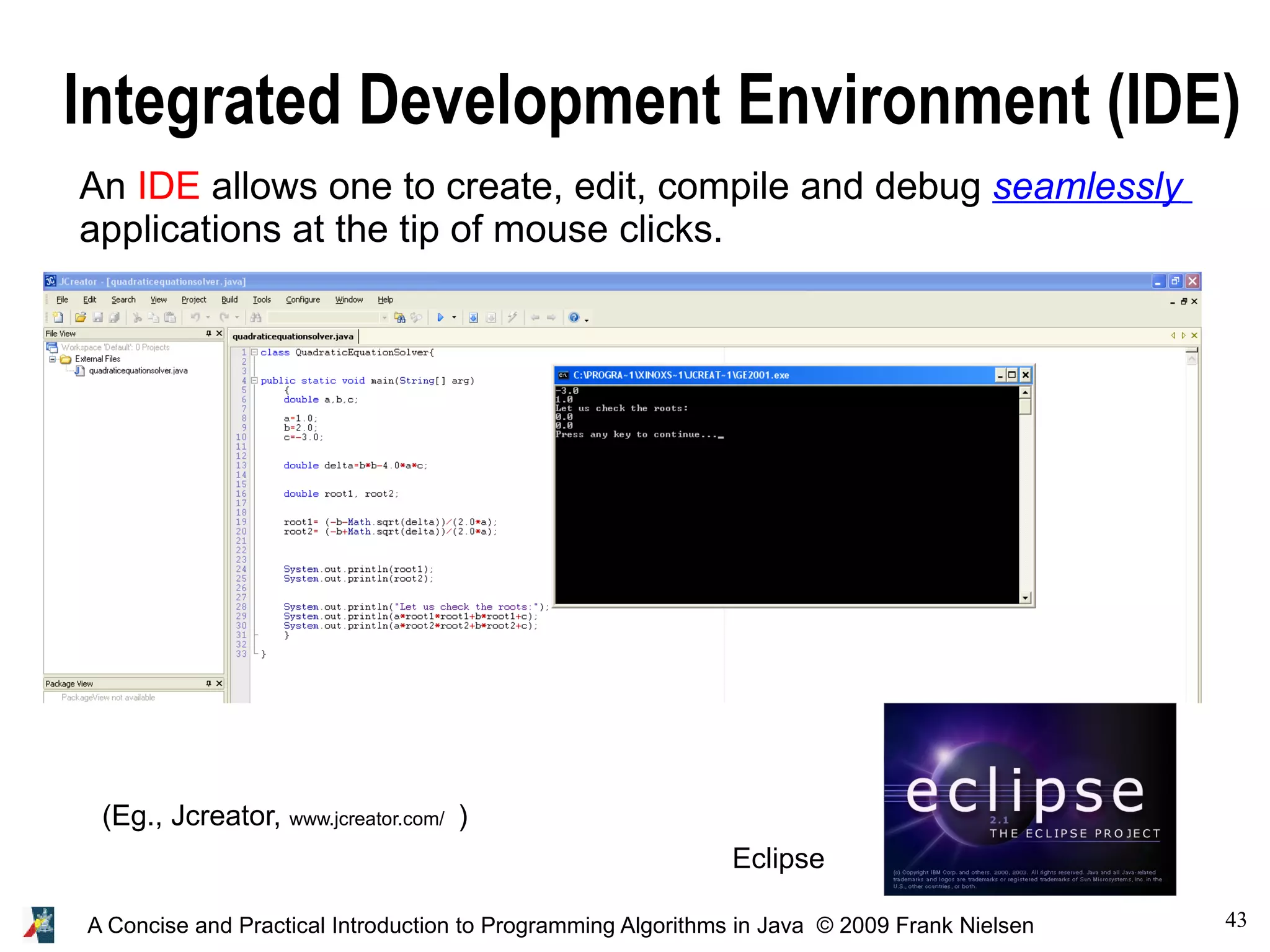
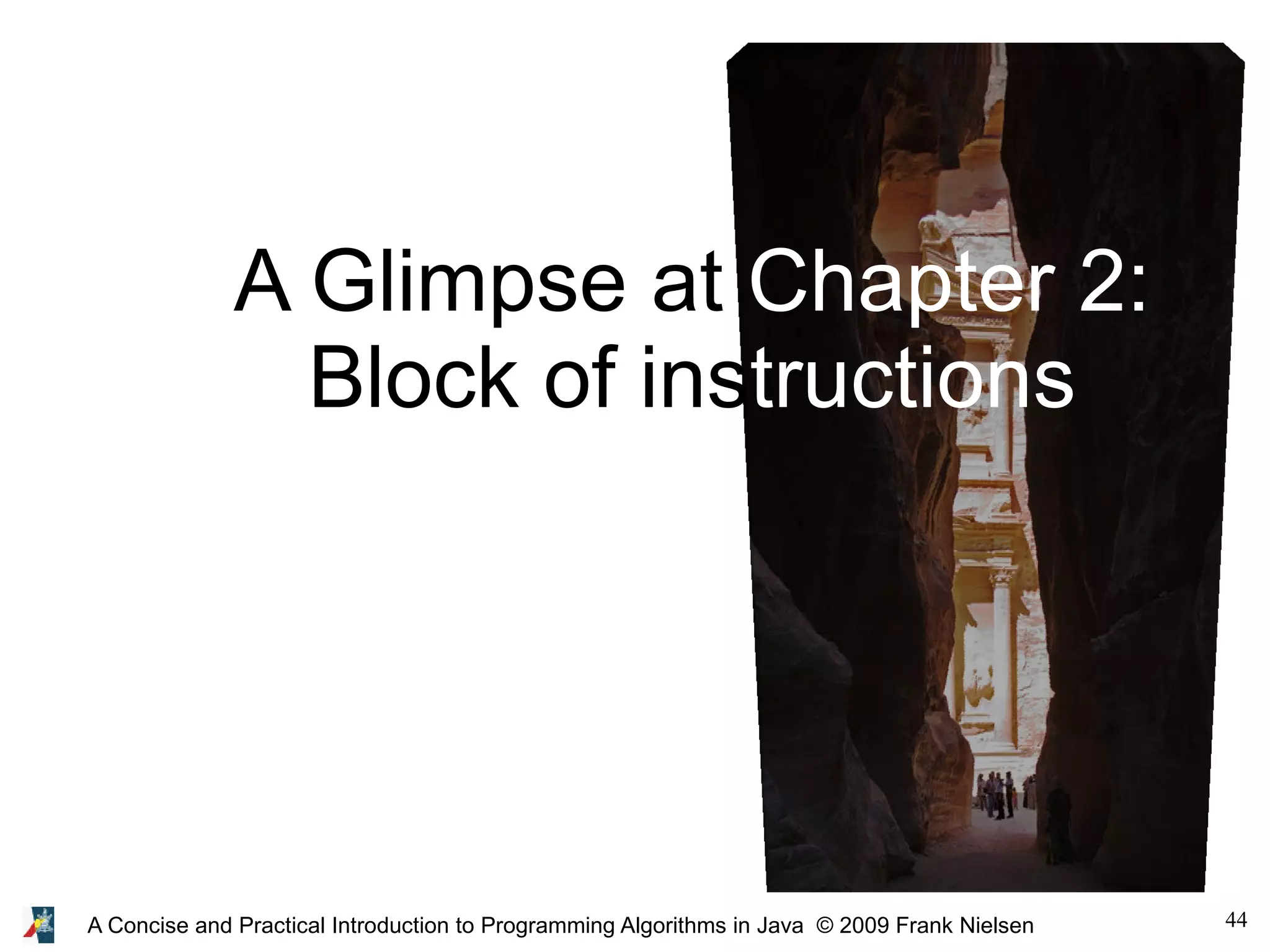
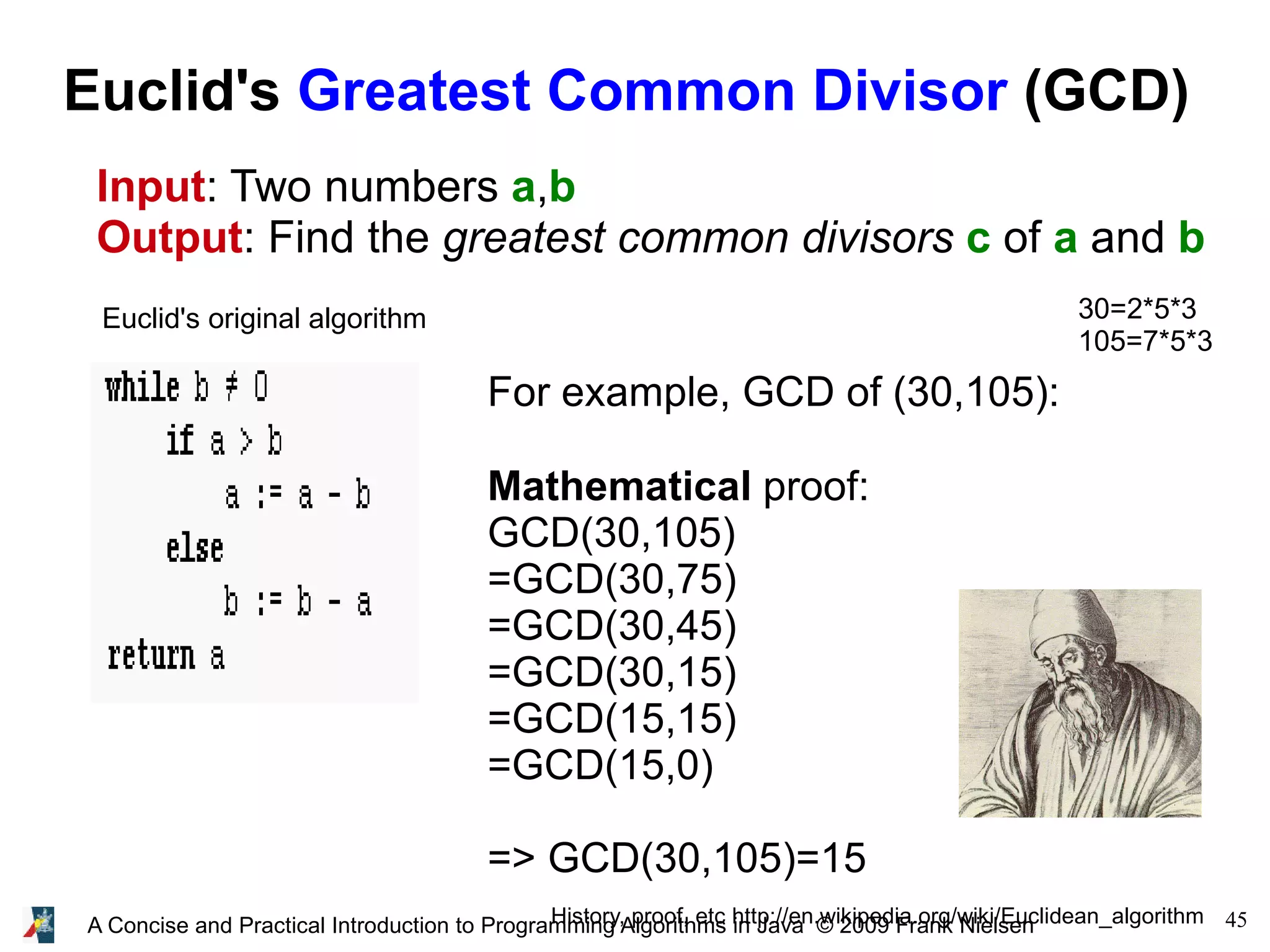
![46A Concise and Practical Introduction to Programming Algorithms in Java © 2009 Frank Nielsen Euclid's Greatest Common Divisor (GCD) Input: Two numbers a,b Output: Find the greatest common divisors c of a and b Euclid's original algorithm History, proof, etc http://en.wikipedia.org/wiki/Euclidean_algorithm class GCD { public static void main(String[] arg) { // Parse arguments into integer parameters int a= Integer.parseInt(arg[0]); int b= Integer.parseInt(arg[1]); while (a!=b) { if (a>b) a=a-b; else b=b-a; } // Display to console System.out.println(a); } }](https://image.slidesharecdn.com/programmingalgorithmsjava-1-140701005144-phpapp02/75/chapter-1-A-Concise-and-Practical-Introduction-to-Programming-Algorithms-in-Java-46-2048.jpg)
![47A Concise and Practical Introduction to Programming Algorithms in Java © 2009 Frank Nielsen Euclid's greatest common divisor (GCD) > javac gcd.java (compile in a gcd.class) > java gcd 234652 3456222 > gcd.txt (execute and store result in gcd.txt) arg[0] arg[1]](https://image.slidesharecdn.com/programmingalgorithmsjava-1-140701005144-phpapp02/75/chapter-1-A-Concise-and-Practical-Introduction-to-Programming-Algorithms-in-Java-47-2048.jpg)
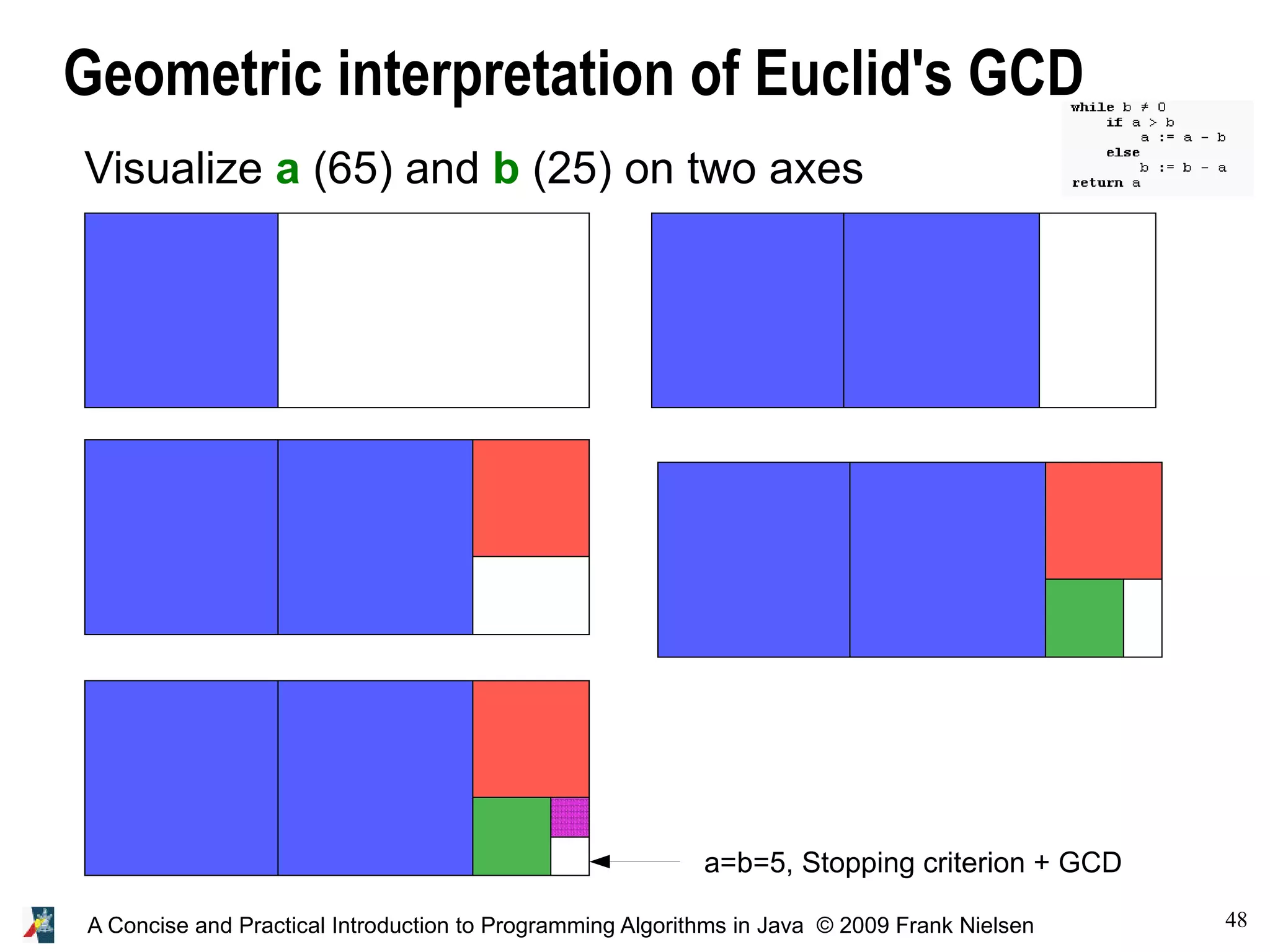
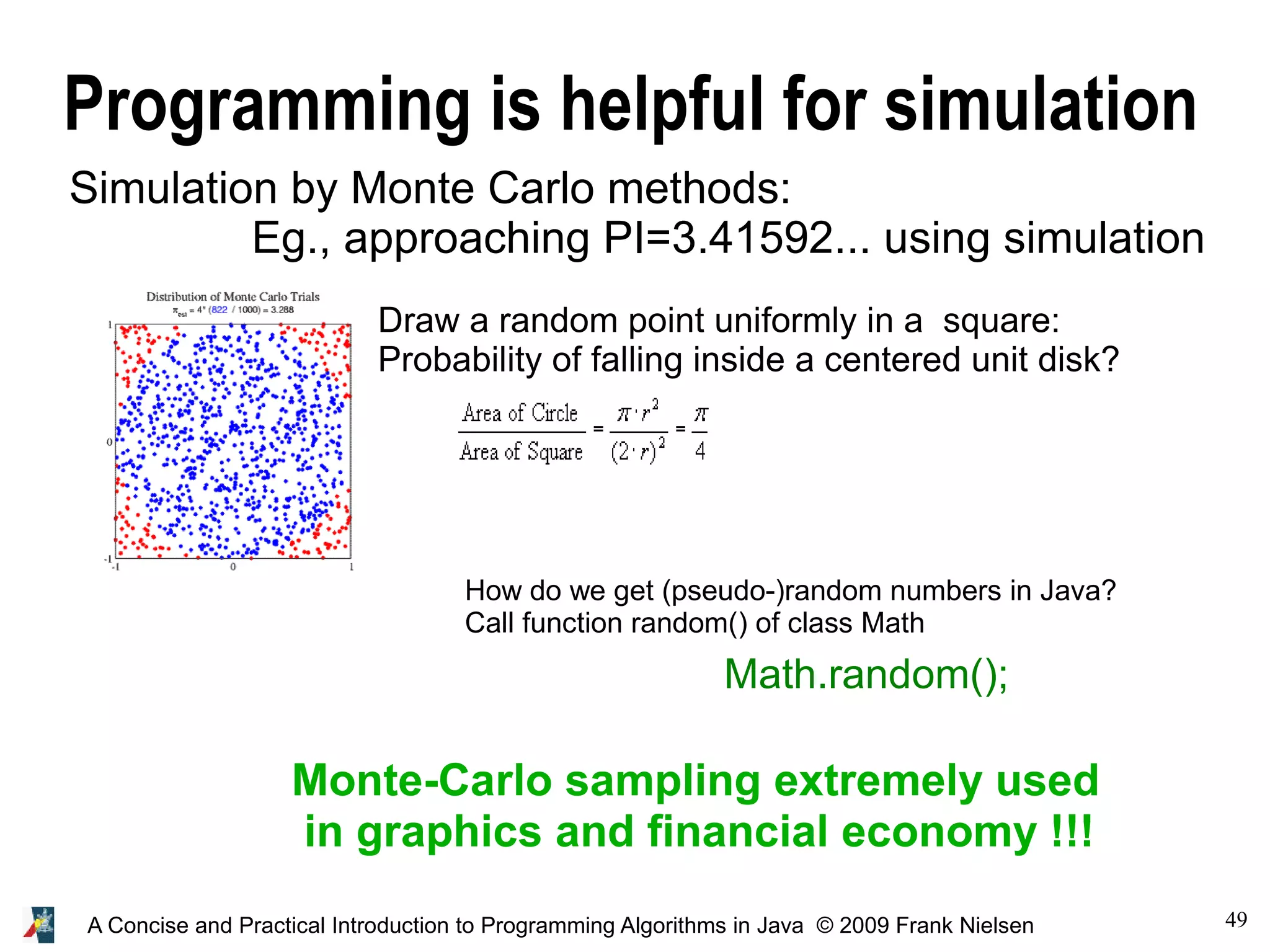
![50A Concise and Practical Introduction to Programming Algorithms in Java © 2009 Frank Nielsen Monte-Carlo estimation of PI in Java Monte-Carlo simulation techniques proved useful in computational sciences import java.util.*; class MonteCarloPI { public static void main(String [] args) { int iter = 10000000; // # iterations int hits = 0; for (int i = 0; i < iter; i++) { double rX = 2*Math.random() - 1.0; double rY = 2*Math.random() - 1.0; double dist = rX*rX + rY*rY; if (dist <= 1.0) // falls inside the disk hits++; } double ratio = (double)hits/iter; // Ratio of areas double area = ratio * 4.0; System.out.println("Estimation of PI: " + area+ " versus machine PI "+Math.PI); } }](https://image.slidesharecdn.com/programmingalgorithmsjava-1-140701005144-phpapp02/75/chapter-1-A-Concise-and-Practical-Introduction-to-Programming-Algorithms-in-Java-50-2048.jpg)
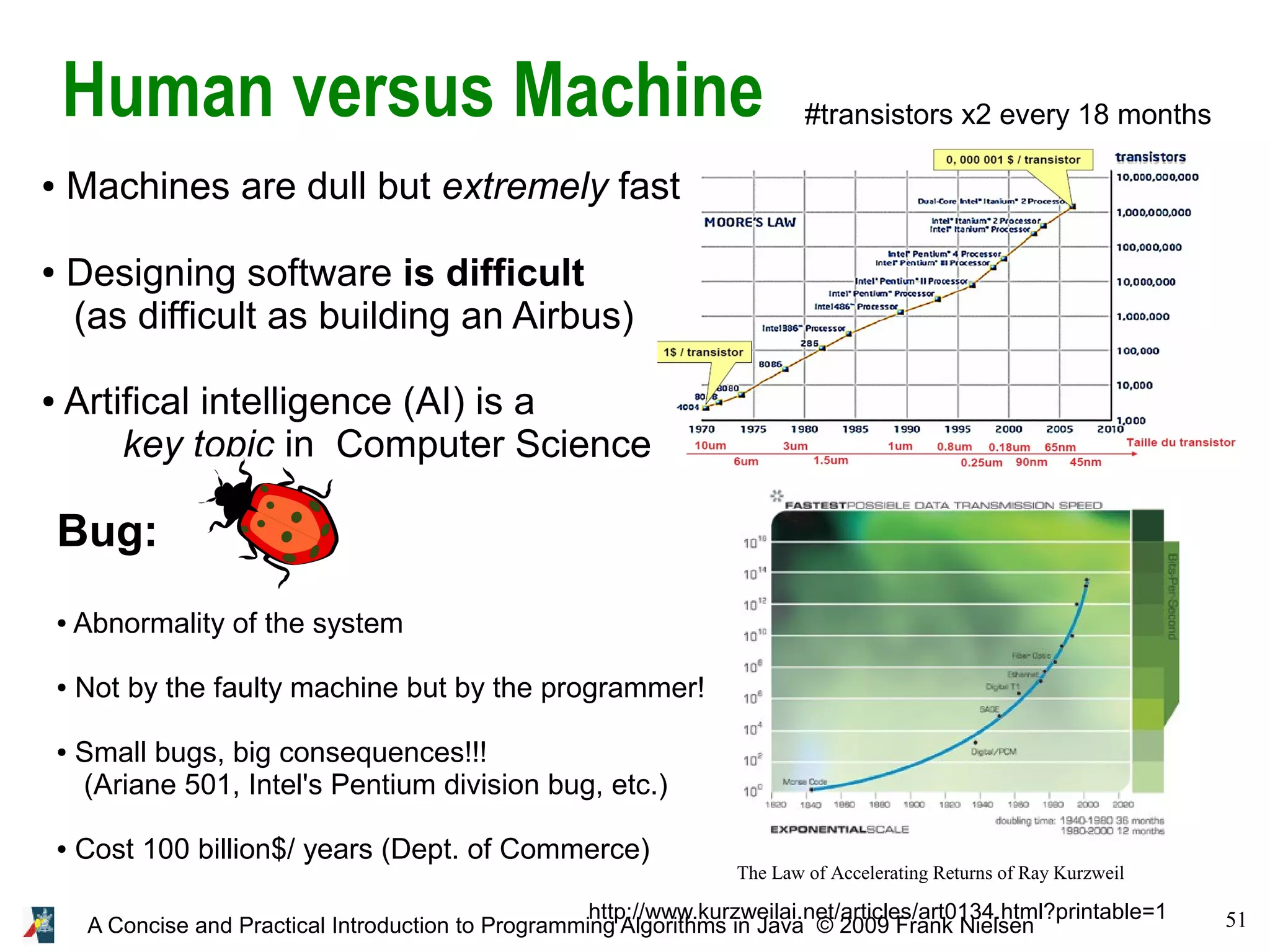
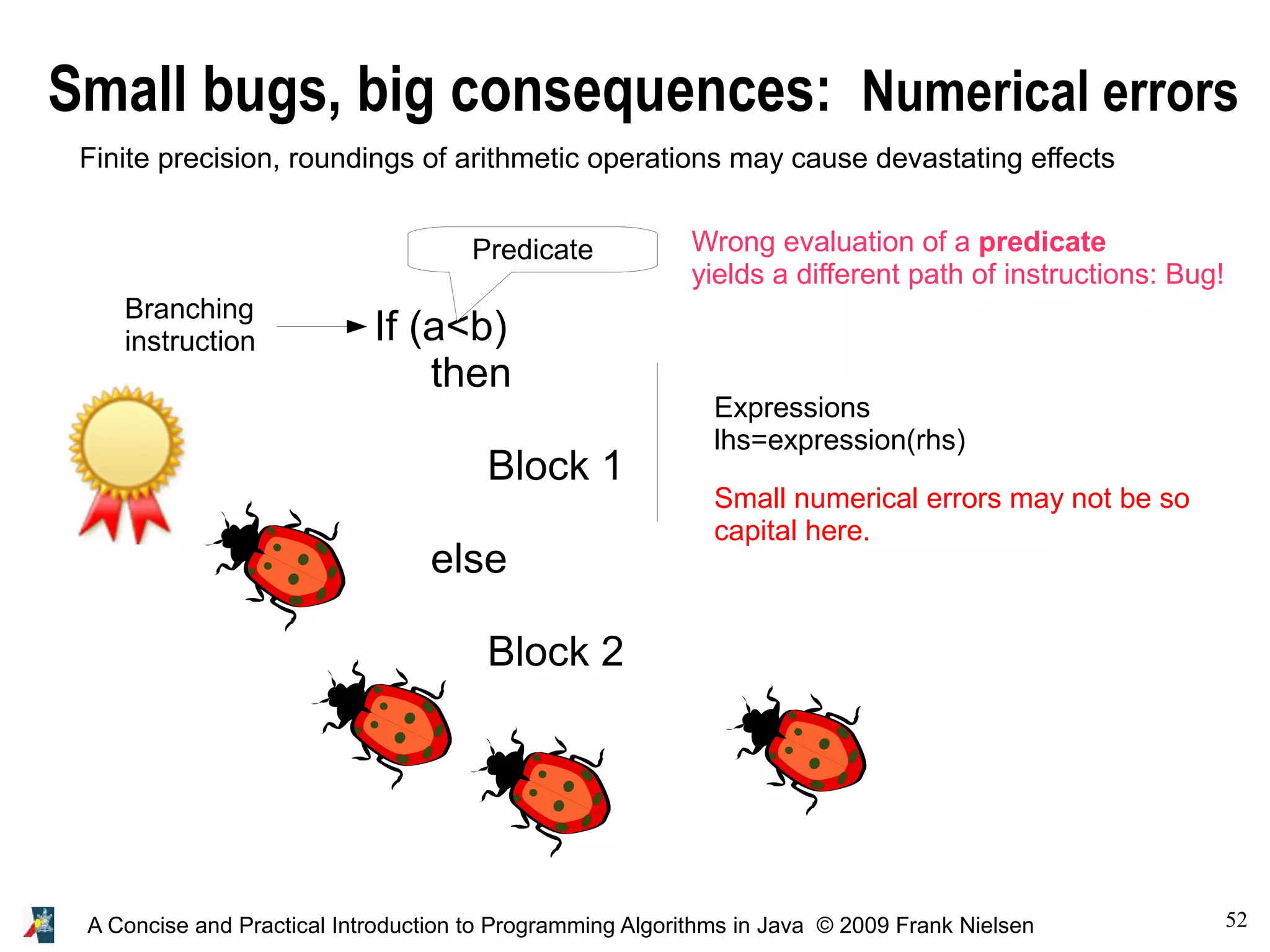
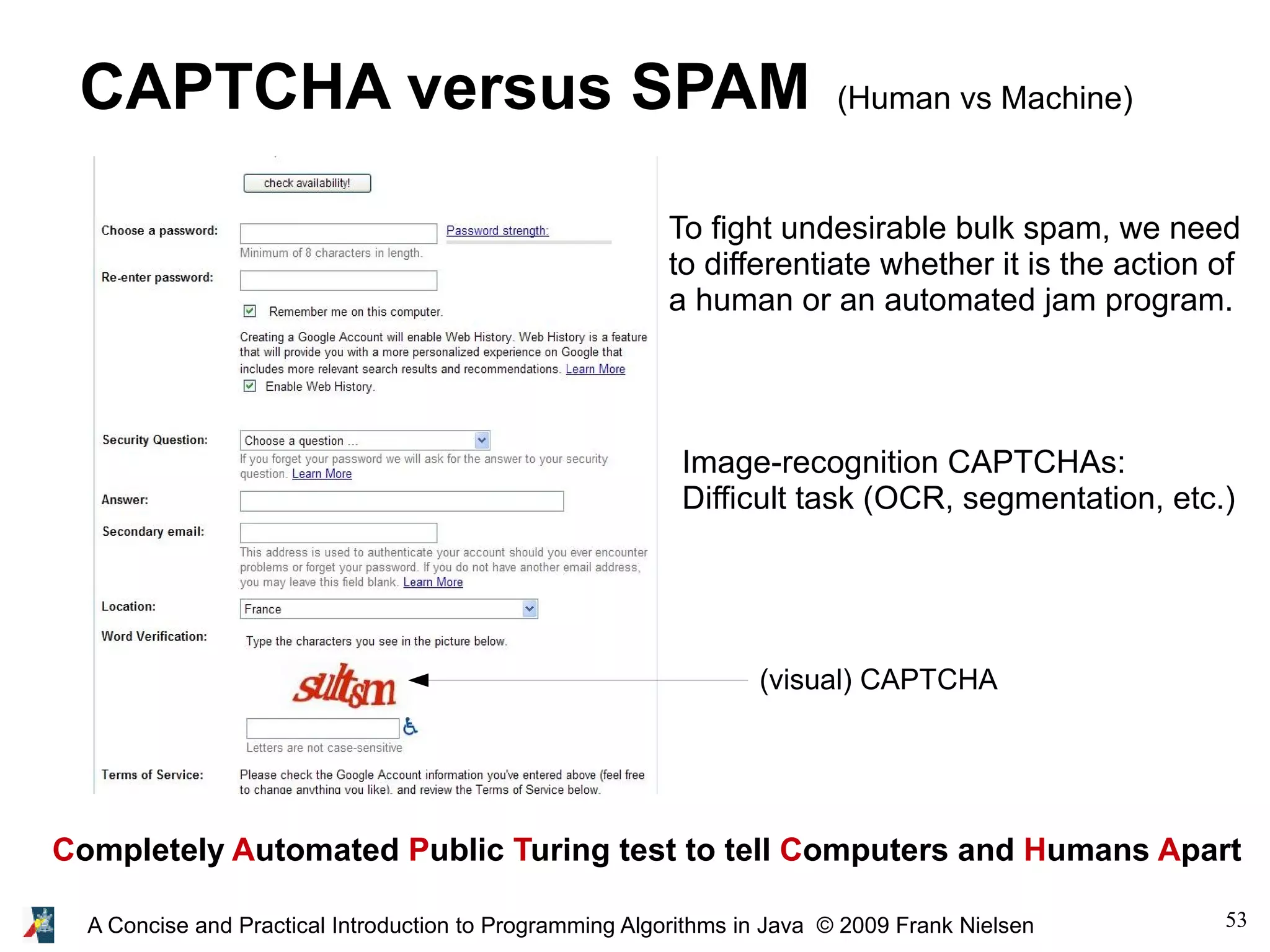
![54A Concise and Practical Introduction to Programming Algorithms in Java © 2009 Frank Nielsen Turing test... Alan Turing, 1912-1954 (41 years old) Pioneer of modern computer science Proposed the “universal” Turing machine: A ribbon, a head, a state and an action table (automaton) Turing test: proposal for a test of machine's capability to demonstrate intelligence. Originally, for natural language conversation (and processing). Initially, by text-only channel such a teletype machine DNA, ribosome Association for computing machinery (ACM)'s Turing Award (250000$) [Nobel prize in computer science]](https://image.slidesharecdn.com/programmingalgorithmsjava-1-140701005144-phpapp02/75/chapter-1-A-Concise-and-Practical-Introduction-to-Programming-Algorithms-in-Java-54-2048.jpg)
